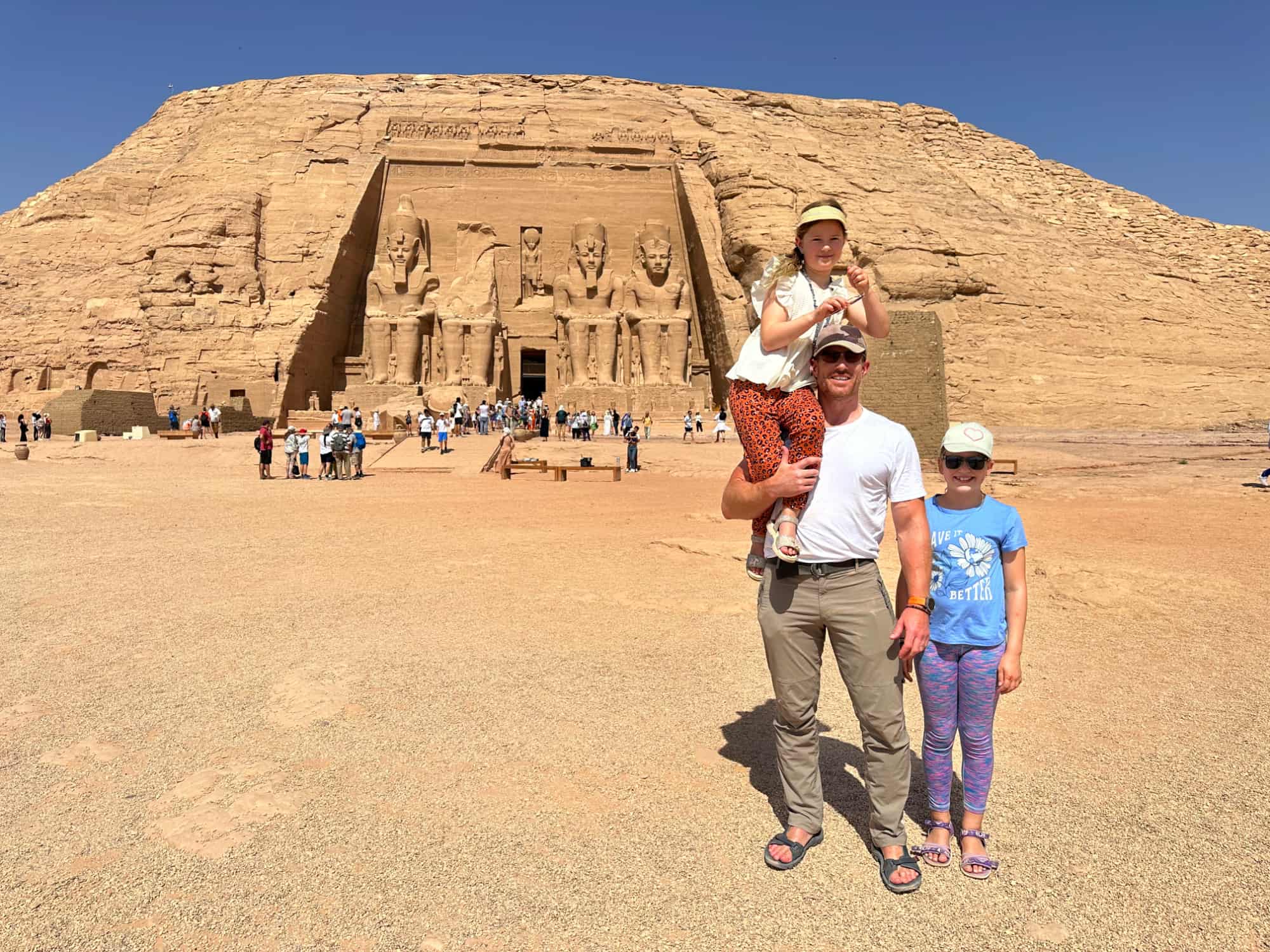Standing at the foot of Rameses II’s 20 metre colossal statues you’d be forgiven for thinking you’d been cast as an extra in Death on the Nile. This was the southern most point on our Egypt itinerary and one of dozens of surreal moments during our full on 10 days experiencing the ancient wonders of the world.
I’ve always been fascinated by ancient Egypt and visited, all too briefly, when I was a teen. That trip was limited to Cairo and the pyramids at Giza. But there’s so much more to Egypt!
So when we were looking for destinations to visit for our Easter break from Oman I quickly jumped on the opportunity to head back to the land of the pharaohs for a better look.
If seeing the wonders of Egypt has always been on your bucket list, but you’re unsure whether it’s too busy, too hot or even safe for families, let me share our experience of visiting Egypt with kids.
*Post contains affiliate links*
Planning a 10 day Egypt itinerary
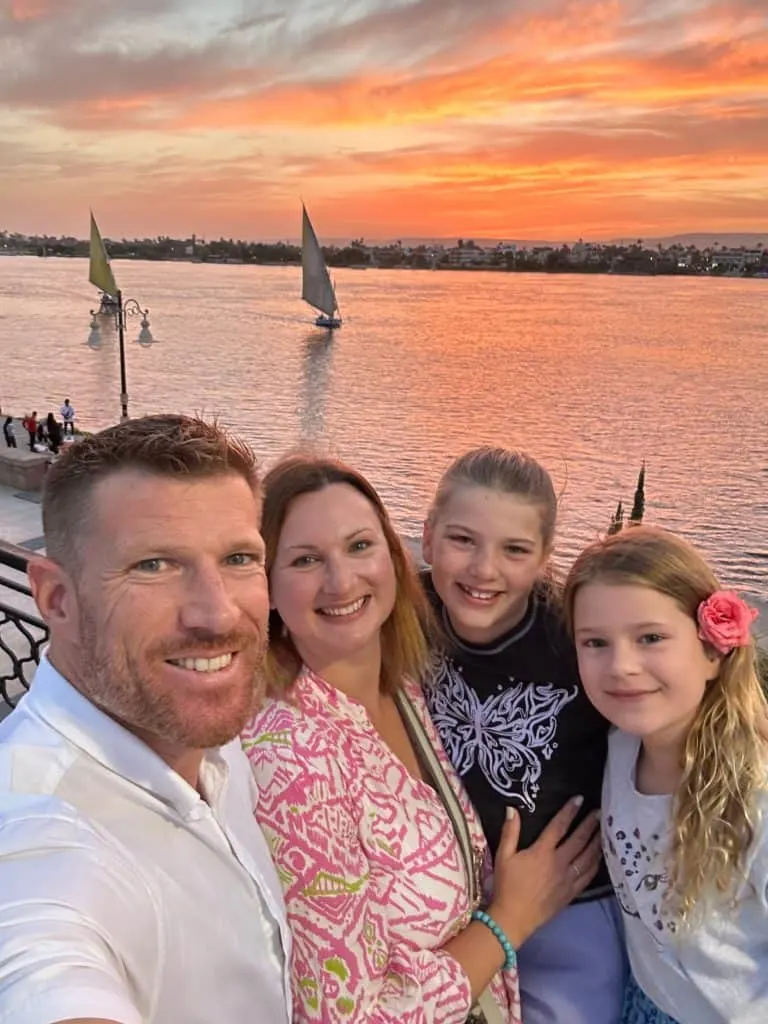
First things first, here’s a few things we learnt while planning our Egypt holiday and while we were there:
Is Egypt safe to visit?
This is something I was asked most on Facebook and Instagram before, during and after our trip.
It’s a fair question. Egypt ranks in the top 20 countries in the world affected by terrorism. And the UK government advises against travelling to some areas.
The conflict in Sudan to the south might also make people think twice about how safe it is to visit Egypt.
Our experience was that we felt very safe.
We didn’t touch on any of the places the UK government advises not to go and we knew our travel agent would react to the latest travel guidance.
There’s no getting away from the fact security is tight.
You will travel through countless police check points where armed officers ask drivers who they have in their vehicle. And there are armed guards at all tourist sites.
Each of our hotels had security people at the front gate and bag scanners in the lobby.
We found this all reassuring rather than worrying.
We had a guide with us almost all the time but on the few occasions we did step outside our hotel or wander around the historic sites on our own we didn’t feel unsafe.
Just like you should every time you go on holiday, make sure you have a good travel insurance policy* that adequately covers the country you are visiting and all of the activities you may do.
Egypt visas
Each person in your family must have a tourist visa unless you are only visiting the Sharm el Sheikh, Dahab, Nuweiba or Taba resorts and staying no more than 15 days.
Visas to travel everywhere else in Egypt cost $25 per person and can be bought online on the Egyptian Government’s official visa website. Ours took 24 hours to come through.
The website is a little clunky, so be patient.
You can also buy visas at the airport before you go through immigration but I prefer to get this kind of detail sorted well before we land.
Flights to Egypt
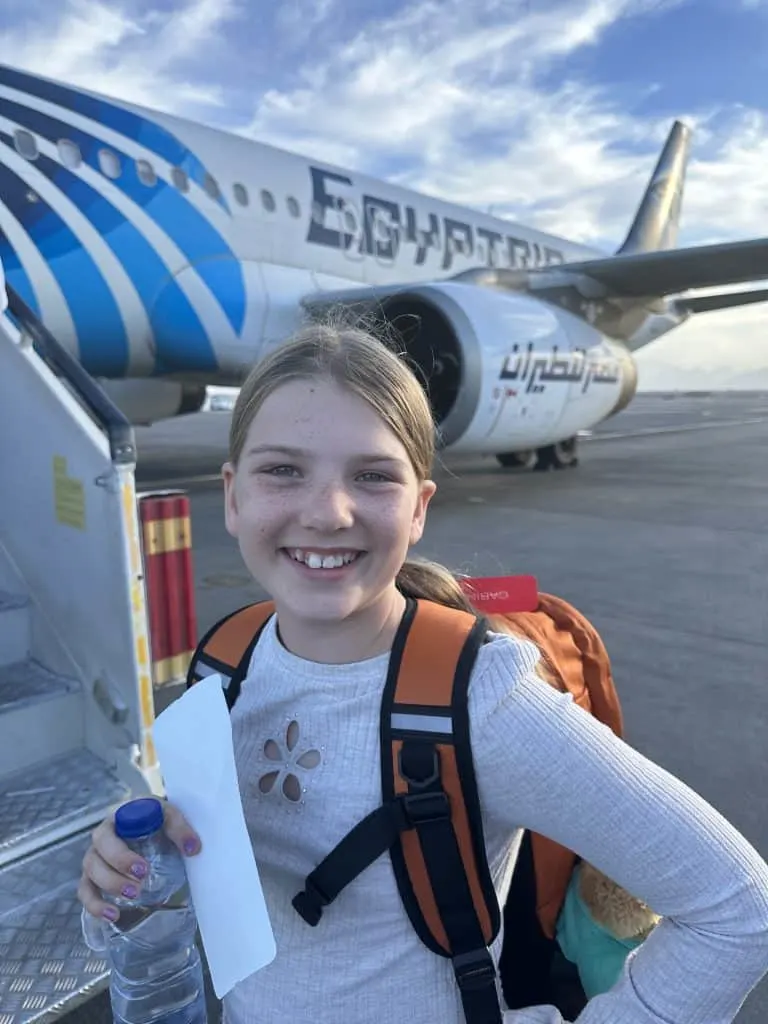
We booked our own flights to Egypt. There are plenty of direct flights to Cairo International Airport from the UK.
If you want to skip Cairo and hop on to Luxor, Aswan or the Red Sea you’ll need to get a connection. Egypt Air is the main airline for internal flights.
We found their website to be a bit ropey and their customer service was really poor when we wanted to change our flight time.
The flight itself – an internal trip from Hurghada to Cairo – was much more pleasant than the pre-travel admin.
If you book your Egypt travel itinerary through a tour operator they can organise all your flights as part of your package.
Currency
Cash is king in Egypt. And with less than 3p per Egyptian Pound (EGP) you will need a wedge of it.
We picked up our currency at Cairo Airport, and at cash machines inside and outside our hotels. It was easy to get our hands on the larger notes this way but it’s useful to have one, five and 10 EGP notes for tipping, and for the toilets at the historic sites and road side loo breaks.
You’ll have to make a purchase to get hold of these or ask if your hotel reception can swap big notes for small ones.
A lot of places, partiality souq traders, will also accept US dollars and Euros.
Travel times

If you want to see a good proportion of Egypt’s ancient wonders you will be doing a lot of travel. For this reason I’m glad we did this trip when the girls were 10 and nearly eight. It was tiring.
They spent a lot of time in our mini bus napping or on their tablets.
I’d brought a bag full of cereal bars, nuts and sweets with us and we topped this up during the trip.
Our longest travel day – aside from our 16 hour journey home – was a nine hour round trip to Abu Simbel. Seven hours of this was on the road.
There were also some very early mornings and late nights.
When we first looked at Egypt as a possible destination we knew we needed to add some downtime to the end of our trip for everyone’s sanity. On relaxation, if we’d had more time, I’d have added an extra day off sightseeing in the middle.
Arranging your Egypt travel itinerary
We booked our trip six weeks before we departed. Moving to Oman has changed the destinations we are exploring but not necessarily our ability to plan ahead long term!
So, to keep things simple, we decided to use a travel agent to make all the arrangements for us.
This is not something we had done before, part from booking cruise excursions and the odd city tour. We usually plan our own day trips and places to stay while on holiday. But with so much to cover we decided to employ the experts.
This took all the hassle out of planning our Egypt itinerary, but also left us feeling more relaxed while we were there. We didn’t need to book or haggle with multiple guides or drivers as we went along.
Having said that, it may have been possible to DIY it cheaper.
If you want to plan your own Egypt itinerary then skip to the next section for some inspiration about the must see destinations to include.
If you’re interested in an honest recommendation for a travel agent, read on.
Egypt itineraries with Families Worldwide
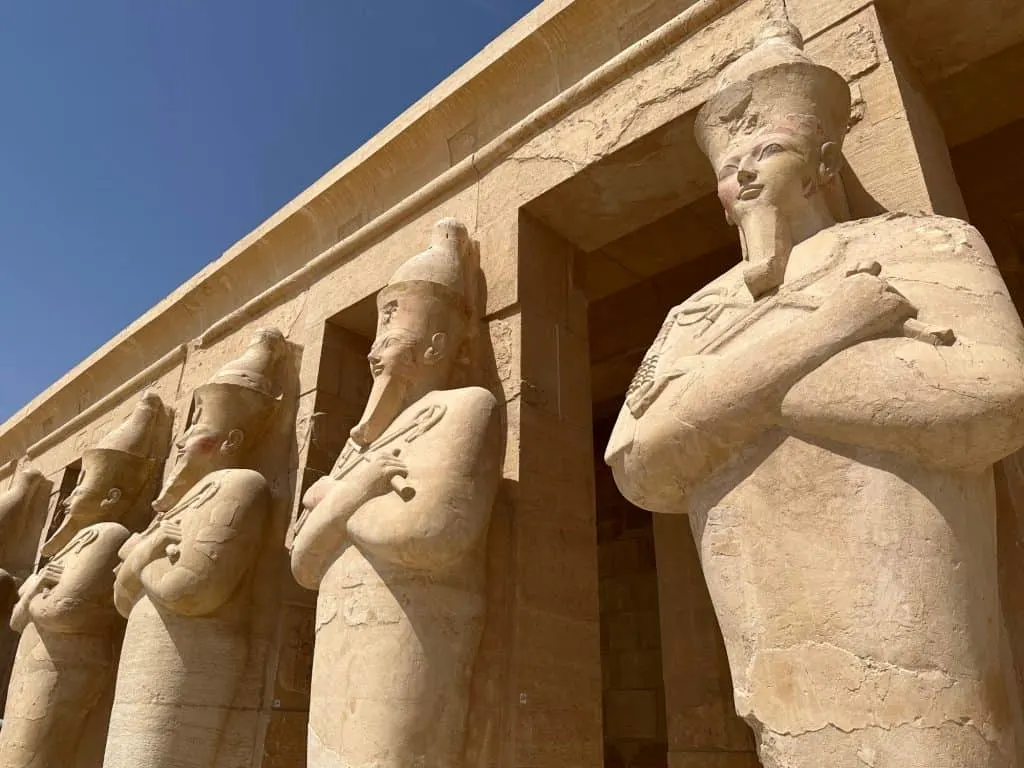
We booked our Egypt itinerary with Families Worldwide who are based in the UK. I don’t have a relationship with this company so I don’t have to mention it, but I want to because we had a great experience.
The only thing we organised was our flights because we were travelling from outside the UK.
Our holiday was for 10 days and was put together for our family based on a suggested itinerary.
Families Worldwide also offer seven day itineraries during which you can join a small group of families or have your own personal guide, like we did. The choice is yours depending on what works best for your family.
A summary of our Egypt travel itinerary
Obviously you can see a lot more in 10 days and that’s why we went for this option. Here’s a quick overview of our Egypt travel itinerary:
- Day 1 to 2: arrive in Cairo, and see Great Egyptian Museum and the Pyramids of Giza
- Day 3: hop to Alexandria on Egypt’s Mediterranean coast to see the catacombs, Pompey’s Pillar and Qaitbey Fort
- Day 3 to 4: the sleeper train to Aswan
- Day 4 to 6: exploring the temples at Philae and Abu Simbel
- Days 6 to 8: exploring Luxor’s temples and the Valley of the Kings
- Days 8 to 10: relaxing at an all-inclusive resort on the Red Sea before flying back to Cairo for an international flight home.
Our Egyptian guide
Adel, our tour guide, with us for the whole 10 days. He has a Masters in Egyptology from Cairo University and a whole bunch of riddles and gruesome facts to keep kids entertained.
Adel was with us from dawn until dusk some days. He was our guide, fixer, translator and he took us to some lovely local restaurants (included in the price of our holiday), so we weren’t limited to hotel meals every night.
The suggested minimum age for this tour is seven. Our girls were 10 and nearly eight and we were happy that everything we did was with their capabilities.
Family accommodation in Egypt
Something to bear in mind is that Egypt’s hotels rarely do family rooms.
We had interconnecting rooms at three out of four hotels and on the sleeper train.
Two of our hotels also had balconies. So, you need to be aware and happy about this if the accommodation is going to work for you.
If you want to find out more about Families Worldwide’s Egypt holidays take a look at their website.

10 days in Egypt with kids
Our holiday was packed with places kids learn about in school, locations where history and mythology collide, and more bucket list experiences than you can shake a camels tail at.
A family holiday in Egypt really is an educational adventure and one that I don’t think we’ll forget in a hurry.
Here’s what we packed into each day as we covered nearly 1,800 miles around Egypt by road, train and plane.
Egypt travel itinerary day 1: arriving in Cairo
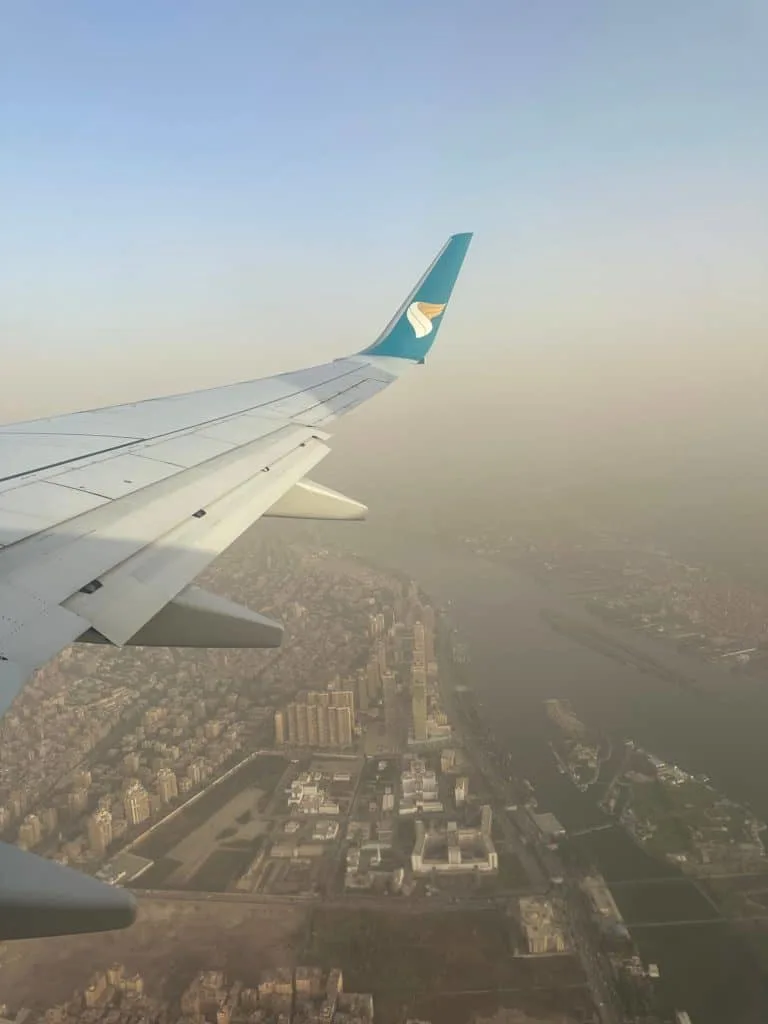
It is Africa’s largest city with a population of 26 million people (unofficial estimates say 35 million). It’s only when you drive through it that you can begin to comprehend its scale.
The roads are the stage for a symphony of honking horns and all manner of vehicles – two, three and four-wheeled – weaving a busy dance.
The air is thick with exhaust fumes and sandstone architecture butts up against tower blocks that have been sliced in half to make way for bigger, even more bustling highways.
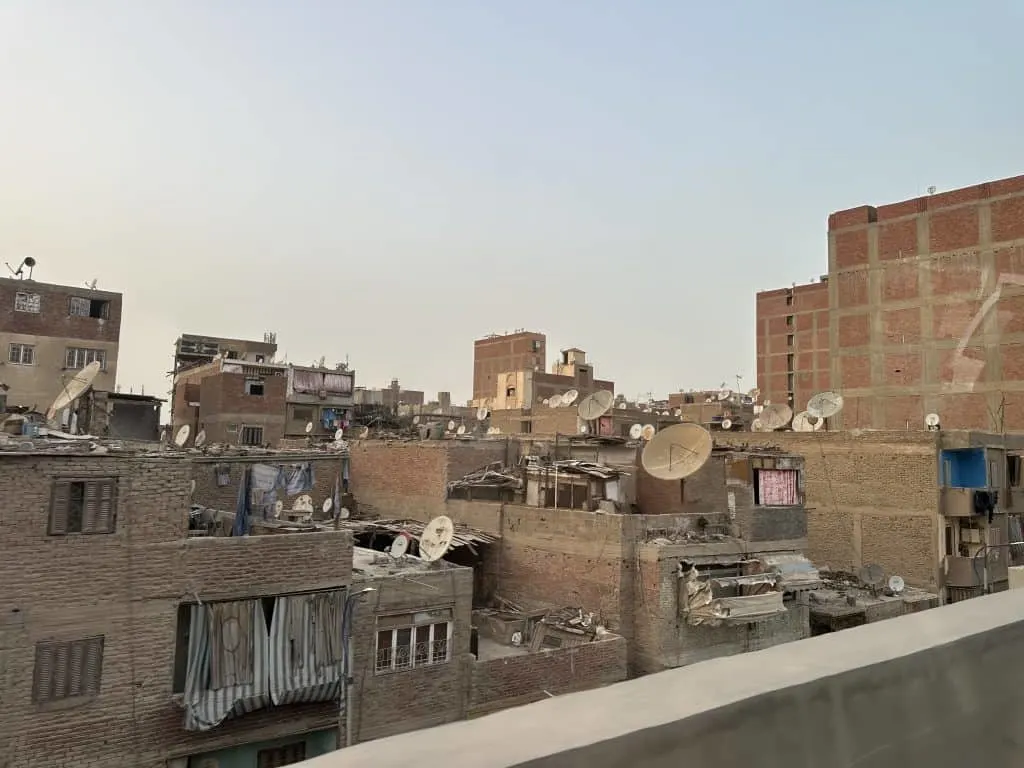
There is so much life. From the small businesses at ground level to the wooden pigeon coups perched on apartment block roofs. Egyptians eat pigeons like Brits eat chickens.
We got a small taste of Egypt’s capital after landing at Cairo International Airport late in the afternoon.
We were met by our Families Worldwide rep who guided us through immigration and arrivals quicker than I think I’ve ever experienced.
Within half an hour of leaving the plane we were out the door and in our private mini bus.
Apparently landing just before sunset during Ramadan worked in our favour. Everyone was keen to break their fast, so the airport and roads were quieter than they might usually be.
We were whisked through Cairo and across the Nile into Giza and our base for the next two nights, the Cairo Pyramids Hotel*.
Night had fallen by the time we arrived. We checked in, dropped our bags in our rooms and grabbed a meal in the hotel restaurant before an early night, ready to start exploring.
Day 2: Cairo and Giza
This morning we met our guide, Adel, who was to travel with us throughout the rest of our time in Egypt.
He lives in Cairo so was able to give us great insights into the city including explaining the language of the honking we’d heard the night before.
Each honk has a meaning based on its length and repetition. ‘I’m here’, ‘I’m coming through’ and ‘you idiot’ (to put it nicely) can all be distinguished from the rumpus if you have the right ear.
This was the first of so many facts we were to learn from Adel about Egypt’s here and now, as well as its ancient history.
Grand Egyptian Museum
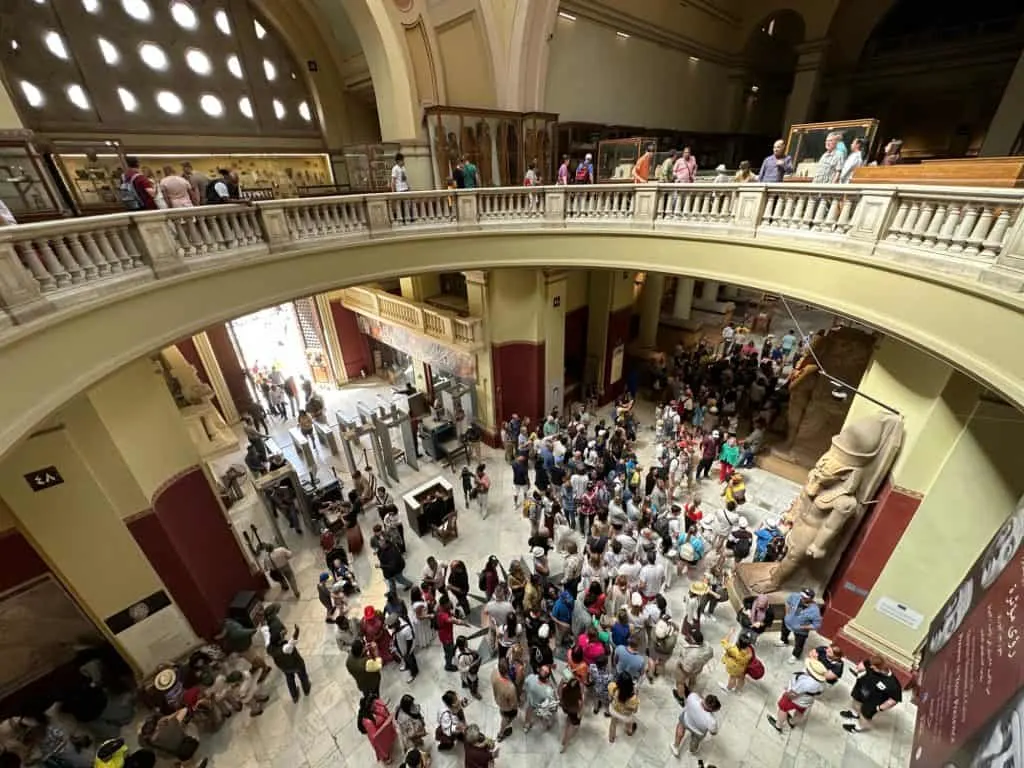
We were picked up at 8am for our first day of sightseeing. And what better place to start than the Egyptian Museum in Cairo. This was a 45 minute drive away through the Cairo traffic.
In its heyday the museum was home to more than 150,000 artefacts.
All but the Rosetta Stone are original. This treasure, which helped unravel the secrets of ancient Egyptian texts, is now in The British Museum in London.
The museum’s exhibits are slowly being transferred to the new Grand Egyptian Museum in Giza. This was slated to open a few years ago but should be open later in 2023. When it does it will be the largest museum in the world.
We drove past the outside and that alone is quite a spectacle.
The fate of the old Egyptian Museum building is still unknown.

In the meantime, it’s showing its age and there are a few empty display cases. It’s still packed with incredible pieces including the haul from Tutankhamen’s tomb – the last and most famous burial site to be unearthed.
The boy king’s death mask and Russian doll like sarcophagus stand out among the others that you see around the halls. And while it can be a bit of a crush to get into this special exhibition it’s a something you have to see.
Why visit the Egyptian Museum?
The museum lays the foundations for the rest of your time in Egypt.
Adel used the displays here to teach us how to distinguish between statues carved for pharaohs who were dead or alive, those who ruled the south, north or both, and where they would have been made.
He also taught us the basics for reading heiroglithics; about the ancient Egyptian’s beliefs around the afterlife; and that being wrapped in the skin of a goat – an ill-favoured animal here – rather than linen bandages was reserved for society’s outcasts.

In one morning my knowledge of ancient Egypt was expanded one hundred fold.
And it really brought the trip alive for the kids. In so many of the snaps our eight-year-old asked me to take you’ll notice her posing as a dead or alive pharaoh.
The Pyramids of Giza

After a lunch of falafel and hummus at a Cairo restaurant we headed back to Giza.
My distant memory of visiting the pyramids when I was a teen was telling me not to be disappointed when they weren’t as large as they look in pictures.
Well, I’d totally mis-remembered. They are just as impressive as you expect, even with the urban sprawl of Giza and Cairo right on their doorstep.

Until the Empire State Building was built in New York, the Grand Pyramid was the tallest structure in the world.
The operation to build the pyramids – at a time when farming had only just been introduced in Britain – must have been awesome. Adel told us if you used the stones from the largest pyramid to make a five metre high wall it would be long enough to surround France.
Top tip: don’t queue and pay to enter the Great Pyramid built for King Khufu. We walked past this to the tomb of his mother, Queen Hetepheres, which is one of the three smaller pyramids beside it.

Entry to this is included in the standard pyramid complex ticket. And when we went there was no queue.
The climb down to the burial chamber is steep and narrow, and there’s nothing as such to see when you reach it, which is apparently a similar to its much larger neighbour. But you can say you have been inside a pyramid.
Camel rides at the pyramids
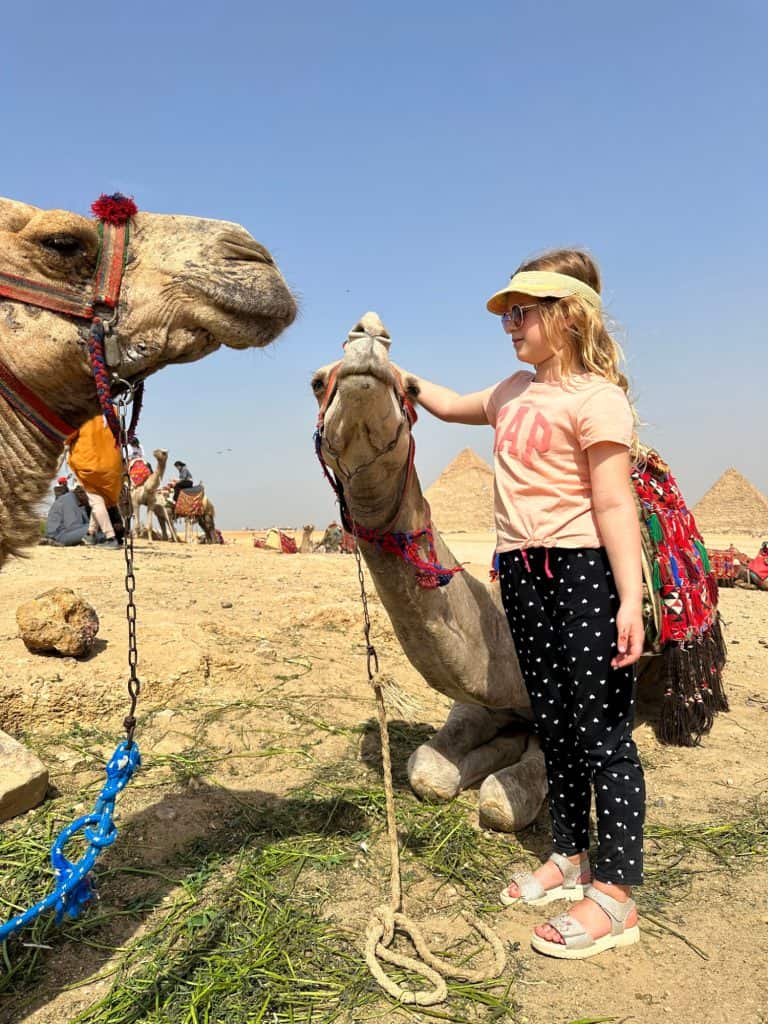
Something we ummed and ahhed about before visiting the pyramids at Giza was whether we’d do a camel ride. We wanted to make sure they were well looked after before subjecting them to carrying our sweaty bodies.
Some of the first camels we saw as we entered the pyramid complex didn’t look that good.
We spoke to Adel about our concerns and he took us to the view point on the plateau above the pyramids where there were more camels.
They looked in much better nick and, as our eight-year-old was really keen, we decided to take a short ride.
Our 10-year-old said she didn’t fancy it and walked alongside us. After a few failed touristy shots we returned to our mini bus for the drive to the last stop of the day.
The Sphinx

This is where my teen memory should have kicked in. The Sphinx, also known as ‘Ra’ to the ancient Egyptians and ‘Father of Terror’ to Arabians, is smaller than you might expect.
It’s still worth a visit, especially to see the temple in front of it where the pyramids’ royal families were mummified among the arrow straight sandstone columns.
It was here that Adel gave us the full gruesome lowdown on the mummy-making process, from scrambling the brains to transferring the organs to urns and wrapping the body from head to toe three times.
And that’s if your family liked you!
If you weren’t in favour, because of some misdemeanour in life, you’d be wrapped in goat skins.
By this point we’d been exploring for six hours and the kids were desperate to get back to our hotel and cool off in the pool.
Our hotel in Giza
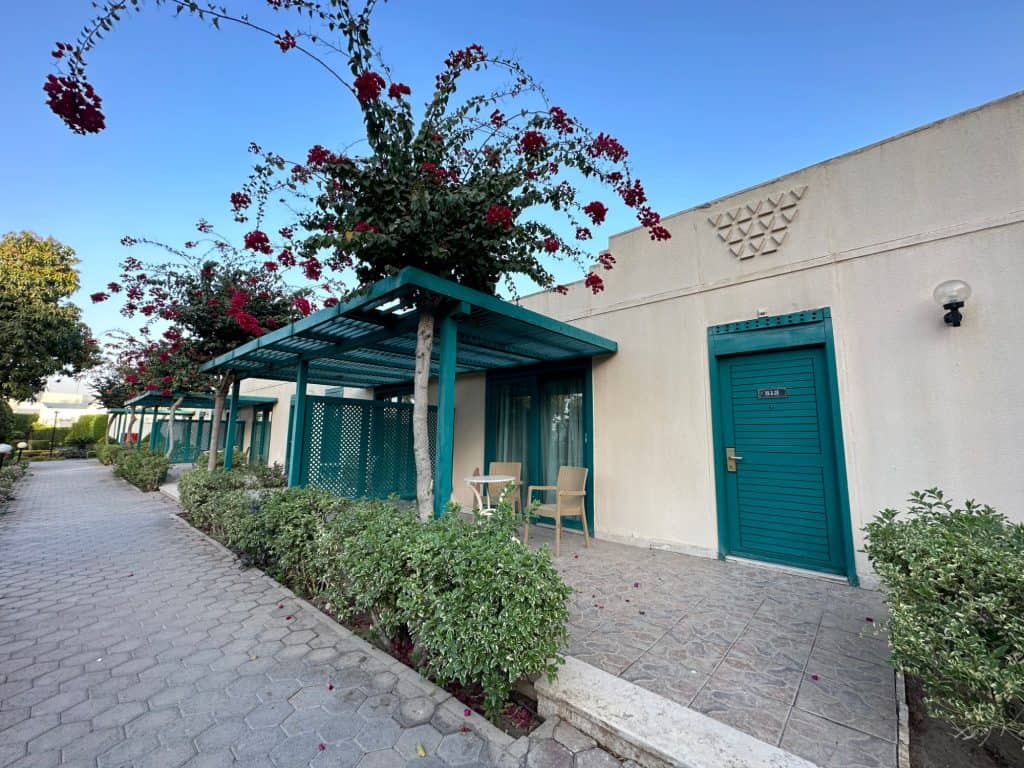
We stayed at Cairo Pyramids Hotel* which is part of the Steinburger Hotel group. I’ll admit this wasn’t our favourite accommodation of our trip but it was functional.
There are rooms with views of the pyramids, but we stayed in a pair of the garden view chalet rooms. These were next to each other but not connected.
They were very tired but clean.
One of the biggest downsides was there was no double glazing, so we couldn’t get away from the roar of Cairo’s traffic. By our second night it was practically white noise. It didn’t disturb our girls at all who slept like pharaohs both nights.
On the plus side, the hotel pool was deliciously cool after a day of seeing the sites.
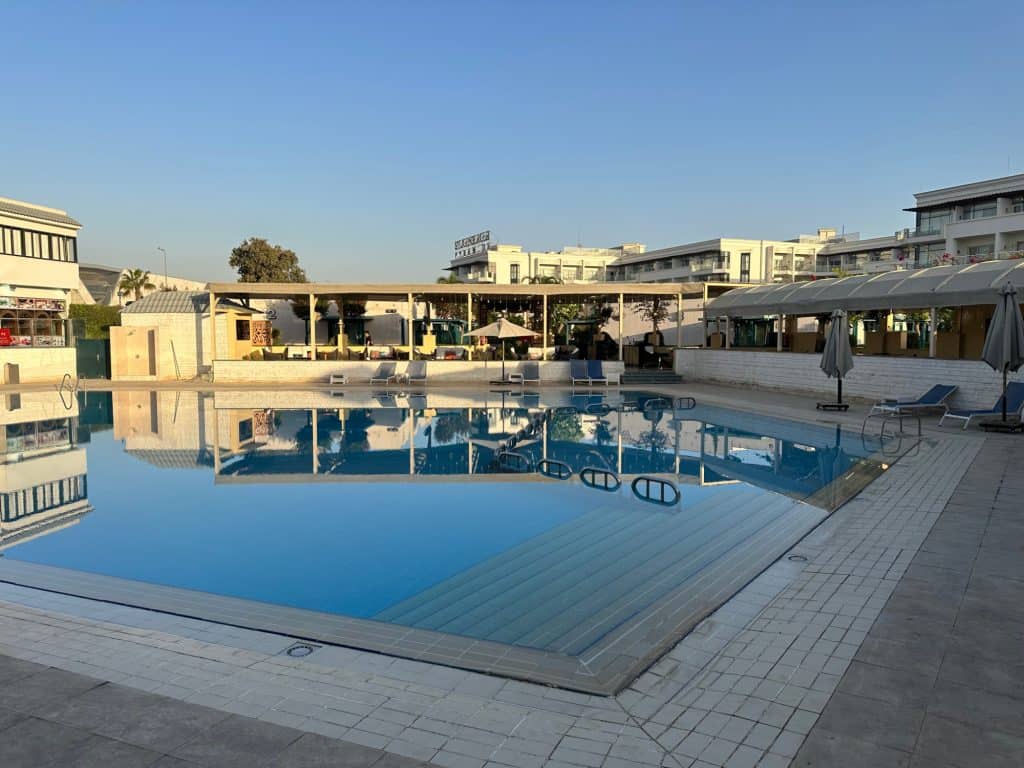
The hotel’s Il Gardino restaurant also had a good choice of reasonably priced pasta, pizza and Arab dishes. We ate here both nights.
There was also plenty of choice at the breakfast buffet with chefs on hand to cook eggs and make pancakes. The restaurant staff were very friendly and efficient.
Check rates for hotels in Giza*
Day 2: Alexandria

This morning we finished packing our bags, grabbed an early breakfast and met Adel at 7am for the three hour drive to Alexandria – home to wonders of the ancient and medieval worlds.
The North of Egypt is very flat and the main road plots a straight course to the coast. Along the way we saw fruit trees, palms and vines from our mini bus windows.
We also spotted many white washed brick cones. It soon became clear these were the countryside’s equivalent of the pigeon coups we’d seen on top of all the apartment blocks in Cairo.
Our destination, Alexandria, sits on Egypt’s Mediterranean coast and is named after after Alexander the Great who brought in the country’s Graeco-Roman era.
But rather than being a reluctantly received conquerer, the Egyptian’s welcomed the Macedonian warrior. He built temples to their gods and worshipped in them too. They even made him the only non-Egyptian born pharaoh.
As a consequence Alexandria feels part African, part European. The sandstone buildings lining its seafront are in the Graeco-Roman style and trams rumble through the ornate streets of the Alpha district where poorer citizens once needed visas to venture.
Further back from the sea the narrow streets are lined with shops that spill out onto the pavement. This is where we were reminded of the busyness of Cairo.
Catacombs of Kom el Shoqafa
Our first stop in Alexandria was the highlight for me. The Catacombes of Kom el Shoqafa are unlike anywhere else we were to see during our Egypt itinerary. Indeed, they are unique in the country and rank among the seven wonders of the Medieval world.
This maze of tunnels carved into the sandstone 11 metres below ground level was originally built in the poorest part of the city as a tomb for a blacksmith and his family.

Over time other families carved out even more tunnels and niches to bury relatives and also prized horses.

Mourners would come and visit the catacombs, bringing picnics with them to eat in a subterranean dining room before returning to the surface.
Their left overs and broken pottery containers are what gave the catacombs their name when they were rediscovered. ‘Kom el Shoqafa’ means ‘mound of shards’, which is what was found after the entrance was stumbled upon at the start of the 20th Century.
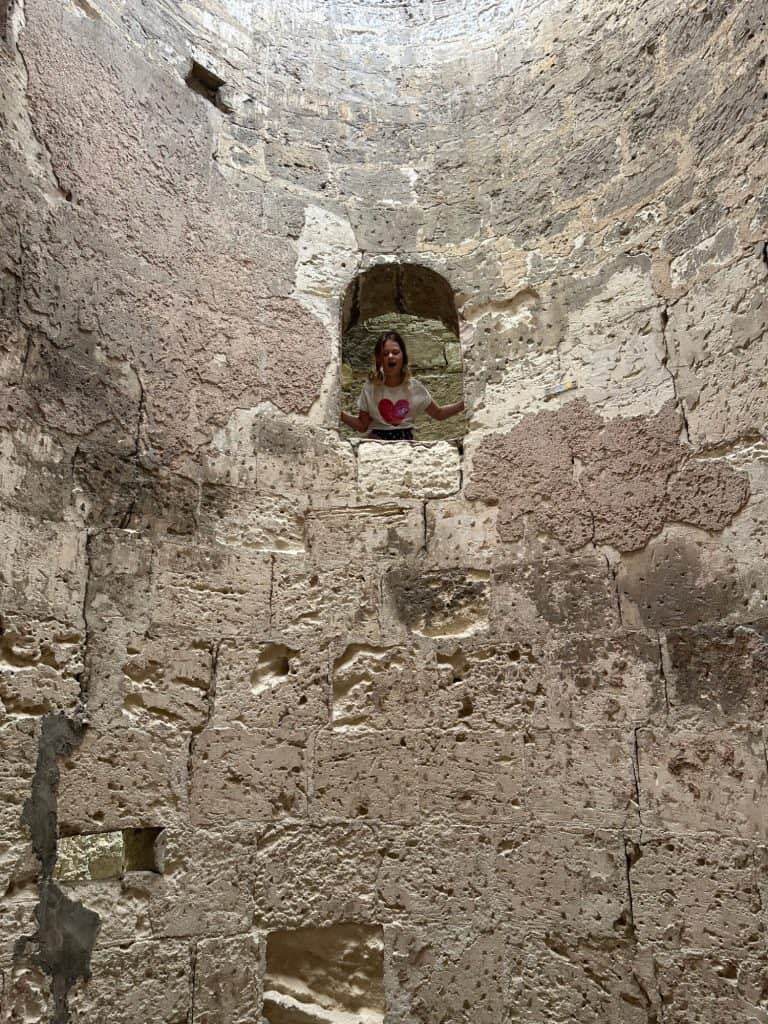
Top fact for kids: a donkey can be credited with rediscovering the catacombs after it slipped and fell into the access shaft. Watch your step in Egypt!
Serapeum of Alexandria and the Pillar of Pompeii
Our next stop was the ruins of what was once a huge Greek temple overlooking the city.
Serapeum was built in the 3rd Century BC in honour of Serapis – a god invented to fit Egyptian and Greek beliefs. The temple would have boasted 400 pillars and a complex of tunnels underground.
Today only one granite pillar stands here along with a pair of sphinx.
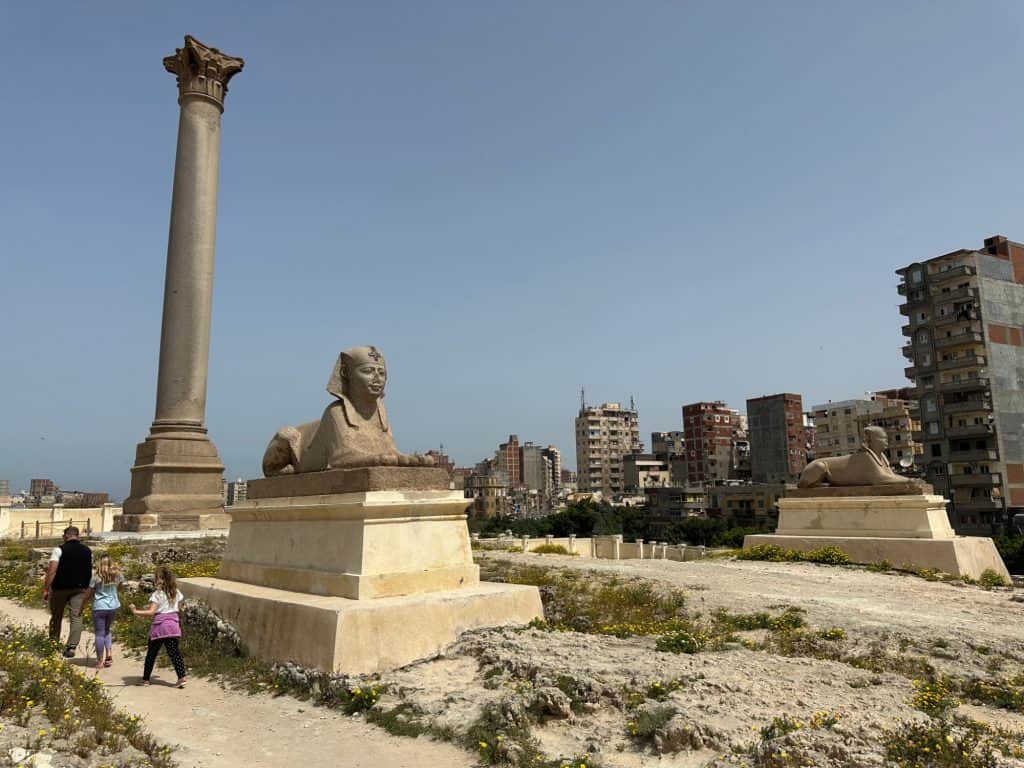
The single pillar is was named ‘Pompeii’s pillar’ by the Crusaders who started the myth that Emperor Pompeii’s ashes were left in a jar at the top.
Today the pillar is surrounded by tower blocks, making it difficult to visualise the old temple’s grandeur.

It’s worth finding the entrance to the tunnels. These used to house a library where many papyrus manuscripts, and mummified cats and baboons were found.
Fort Qaitbey

Our final stop before lunch was Alexandria’s harbour – the site of another of Egypt’s ancient wonders, Alexander the Great’s lighthouse.
This famous lighthouse was built in the 3rd century BC and was thought to have been more than 110 metres in height. The facts are unclear as it was destroyed by an earthquake in the 12th Century.
In the 15th Century, the lighthouse’s sandstone blocks were used to create nearby Fort Qaitbey, which now oversees Egypt’s deep blue Mediterranean coast.
Its walls are a mere 11 metres high, but it still housed 500 soldiers in war time and had its own reservoir and mosque.
Fort Qaitbey has plenty of windows to peer out, and battlements and tunnels making this a fun place for kids to roam around.
Day 2 to 3: Sleeper train to Aswan
After four hours exploring Alexandria we hit the road back to Cairo for the next exciting phase of our Egypt itinerary – the journey to Aswan and the temples of Southern Egypt.
We arrived back in Cairo in the thick of the pre-Iftar traffic.
It wasn’t just the locals who were intent on food. We also needed to pick up some snacks and water for our overnight ride on the Cairo to Aswan sleeper train.

We were really looking forward to this experience as none of us had ever never taken a sleeper train before, let alone with kids in tow. So we expected it to be a memorable experience – and we weren’t wrong!
Have a read of my account of what it’s like to ride the sleeper train from Cairo to Aswan for the full low down.
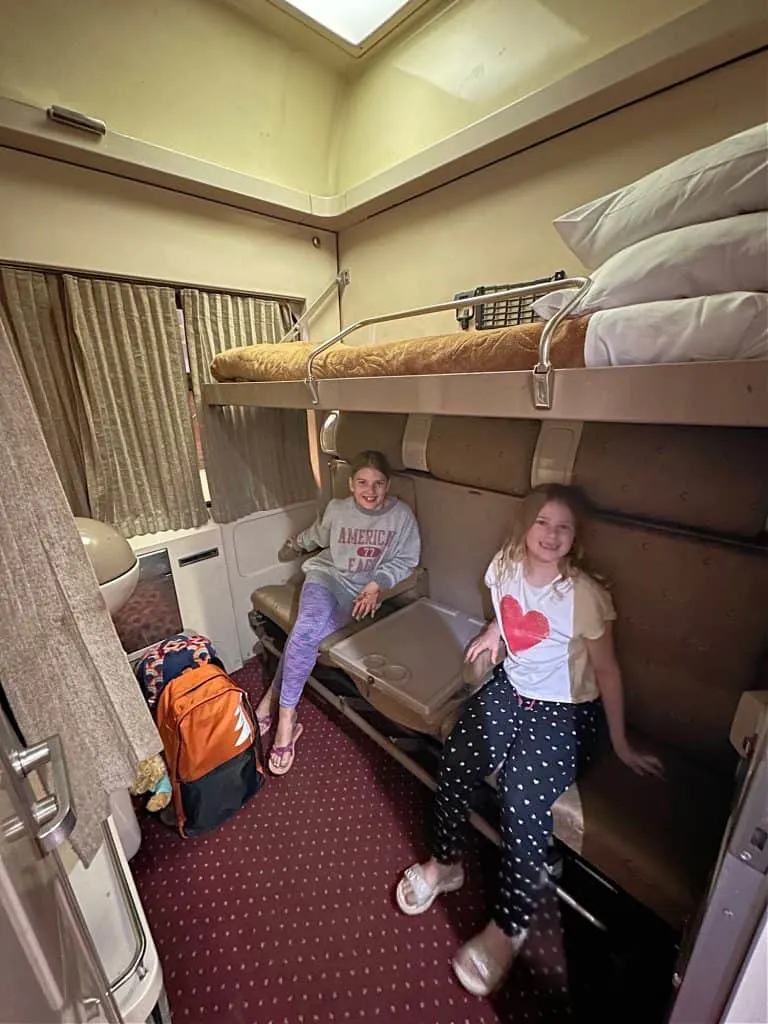
But in summary and to be brutally honest, it is a very raw travel experience. Think of the Orient Express. And now imagine its grubbier, more fidgety three-year-old sibling.
At times it’s exhausting and it would definitely benefit from a thorough scrub. But it’s also has its endearing side.
For example, the views in the morning. And knowing you’ve traveled 879km along side one of the world’s most famous rivers.

Am I glad we did it? Yes. Would we do it again? Probably not in Egypt.
If you’re wondering if it’s for you please do read my full blog post about it for tips and more information.
Day 3: Aswan and the Temple of Philae
When we woke the next morning we were well on our way to Aswan – Egypt’s smallest and most southern city.
It’s physically and characteristically a world away from Cairo despite sitting alongside the same great river. The low rise cityscape on the east side of the Nile overlooks plantations backed by sand dunes speckled with tombs on the west.
And there’s a comparative sense of calm with fewer vehicles on the roads and much less honking. The river is almost busier than the roads.

Aswan was my favourite of all the Egyptian cities we visited.
It comes with its fair share of history and manmade marvels. At 10.30am we rolled straight off the train and into another private mini bus to begin sightseeing.
Aswan’s dams
Thankfully we didn’t have too much driving to do after our overnight train experience. Our first stop was Aswan’s Higher Dam, which we reached by crossing the Lower Dam.
Aswan is the point on the Nile where the Egyptians built a dam in 1897. Its job was to regulate the flow of the river and stop the land to the north flooding. This allowed for crops to be grown all year round.
In 1970, the Higher Dam was completed up river. This generates all of Egypt’s electricity.
While that sounds brilliant, the dam and the creation of Lake Nasser behind it displaced more than 50,000 people whose villages were consumed by what is now one of the world’s largest artificial lakes.
Seven ancient temples between the Higher and Lower Dam fared better and were moved stone by stone to higher ground.
After a brief stop on top of the curved embankment, with an estimated 2,000 crocodiles on the lake side and a 111 metre drop on the other, we set off to see one of the saved temples.
Temple of Philae
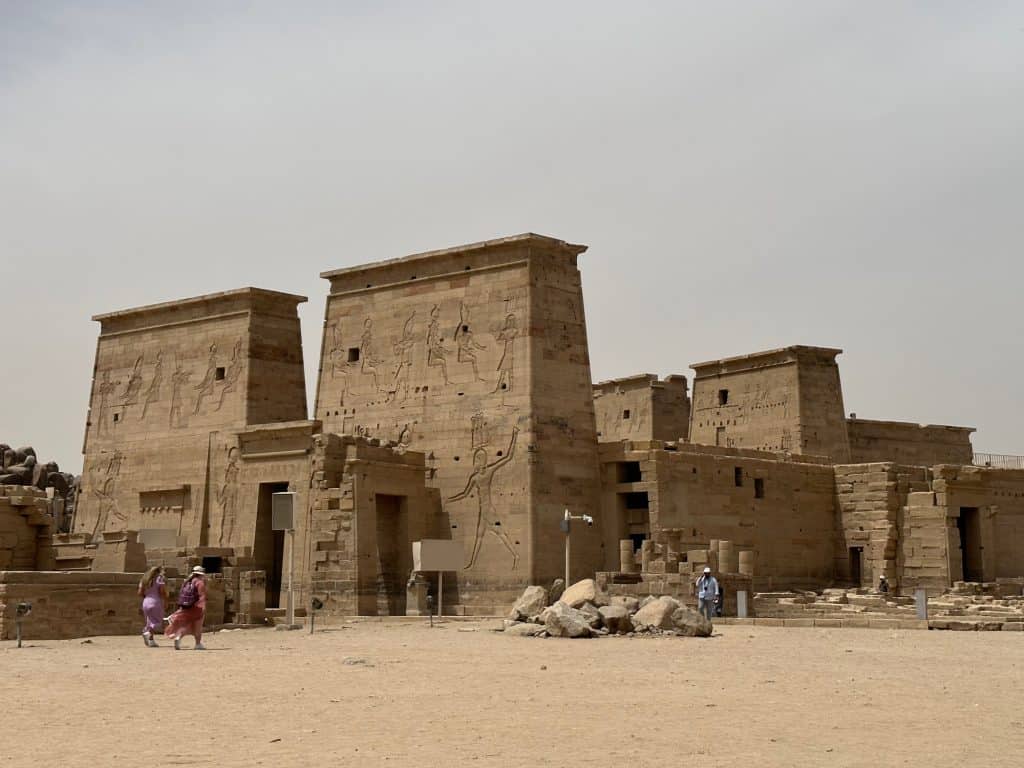
Philae is a Graeco-Roman temple built for the Goddess Isis in the 3rd Century BC. As you walk between the columns and marvel at its hieroglyphics it’s incredible to think it used to stand 500m away.
Before the Higher Dam was built this temple was dismantled and recreated stone by stone on the Island of Agilkia.
This was our first chance to get up close with hieroglyphs in their original setting.


One of the highlights for the kids was how we reached Philae – by boat.
It’s just a short ride across the reservoir between the dams but it allows you to see this wonderful place from all angles.
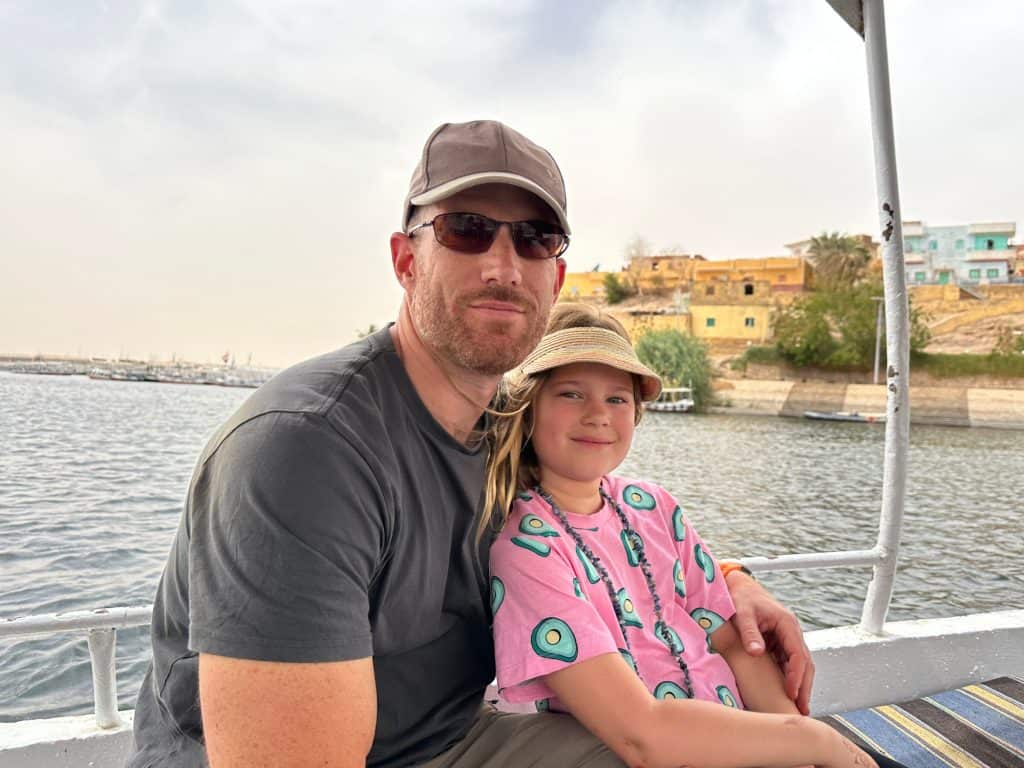
And the light breeze and touch of spray as we whizzed across the water was the perfect refresher. The temperature had increased considerably between Cairo and Aswan.
The boats ferrying visitors to the island are run by Nubians whose families once lived in the Nile Valley that is now Lake Nasser. You’ll see plenty of their crafts and handmade souvenirs on the jetty.
After our visit we returned ashore and it was a short drive to our next hotel, the Toilp Aswan*.
We grabbed a late lunch and relaxed by the pool, which is right beside the Nile.
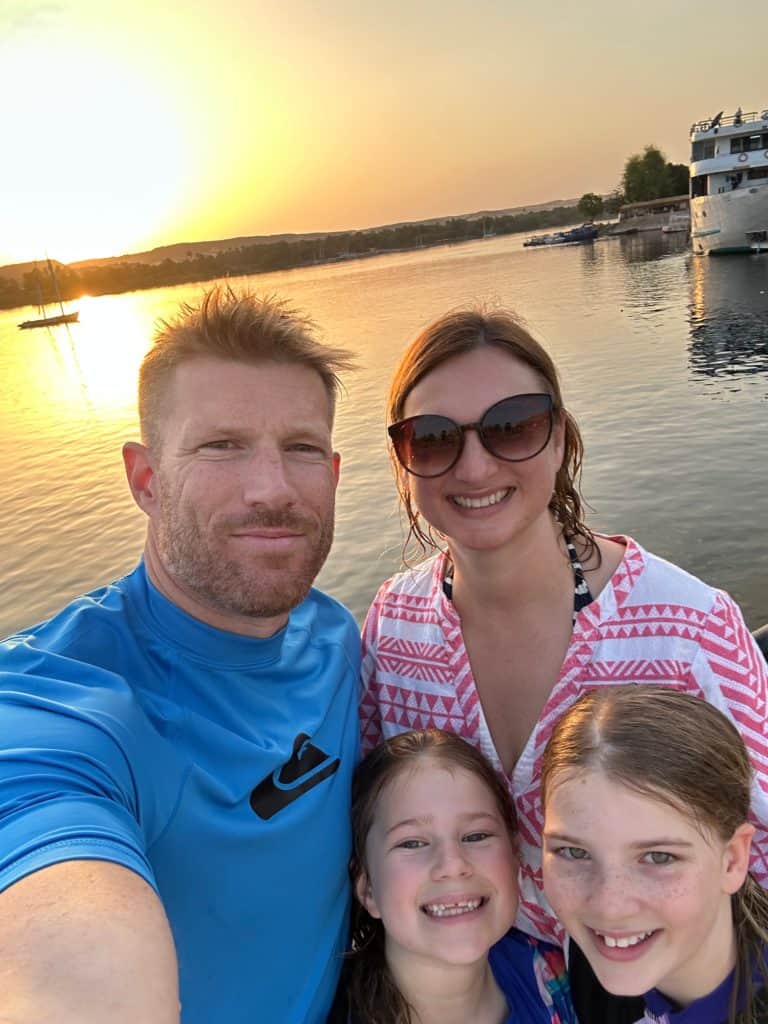
Come evening, Adel whisked us off for dinner at the Nile-side Salah El Din Restaurant where we had piping hot chicken and vegetable tagine with rice while the sunset.
We had the option of exploring Aswan by night but decided we better get an early night. There was another long day of travel ahead of us.
Day 4: Abu Simbel
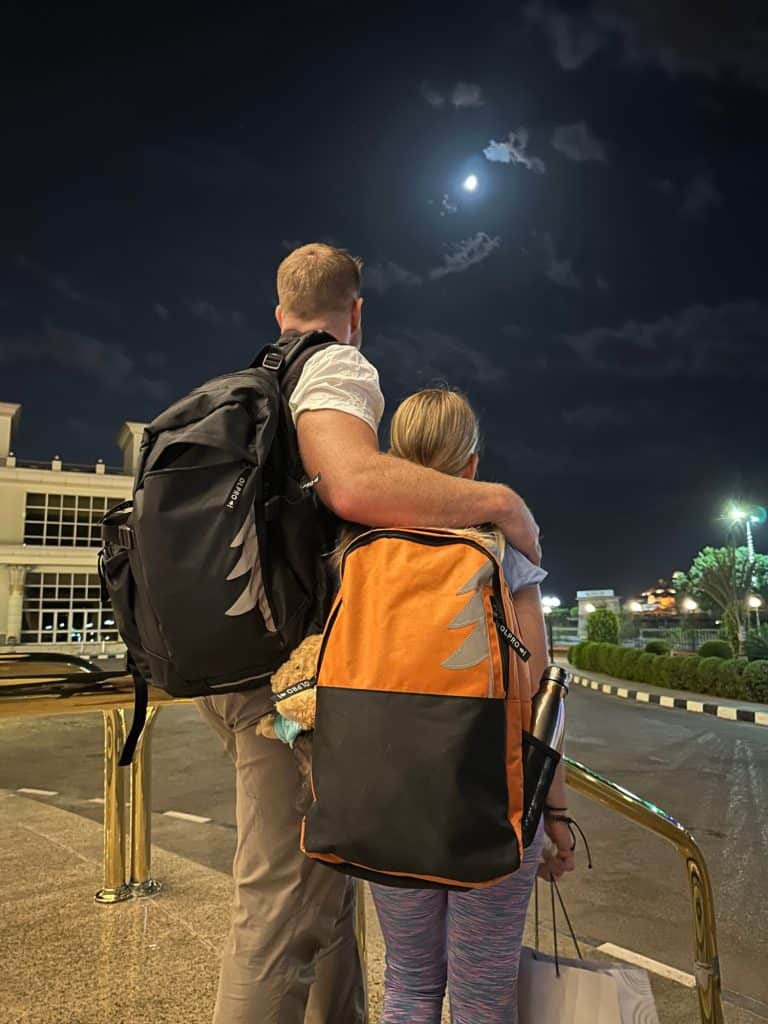
3.45am. It’s not a time I see often now we’re beyond the baby years. But when you’re on your way to meet Rameses II he demands an early start.
Forty-five minutes after our alarms went off we were up and in the lobby to meet Adel who was weighed down with four packed breakfasts prepared by our hotel.
Day trip to Abu Simbel

Adel has been a tour guide for more than 20 years, so has done this trip countless times. He told us that three convoys of tourist buses used to set off from Aswan between 4am and 5am each day. Miss the convoy and you couldn’t go.
Now the rules for travelling along the desert road to Abu Simbel are more relaxed. Tours can set off when they are ready but they can only travel along the road between 5am and 5pm when the check points open.
Abu Simbel is only 12 miles from the Sudan border, so security is tight.
The three and a half hour, 175 mile journey is on a tarmac road that runs through the desert. Once you leave Aswan it’s a fast road with few speed bumps and rough sections, so we were able to grab a bit of extra sleep.
Along the way the tour buses and cars play leap frog as they jostle for the earliest arrival spot.
Inevitably everyone day tripping from Aswan arrives at around 8.30am and leaves by 10am. We stayed an extra half hour and noticed this totally surreal place quietening down.
What is Abu Simbel?
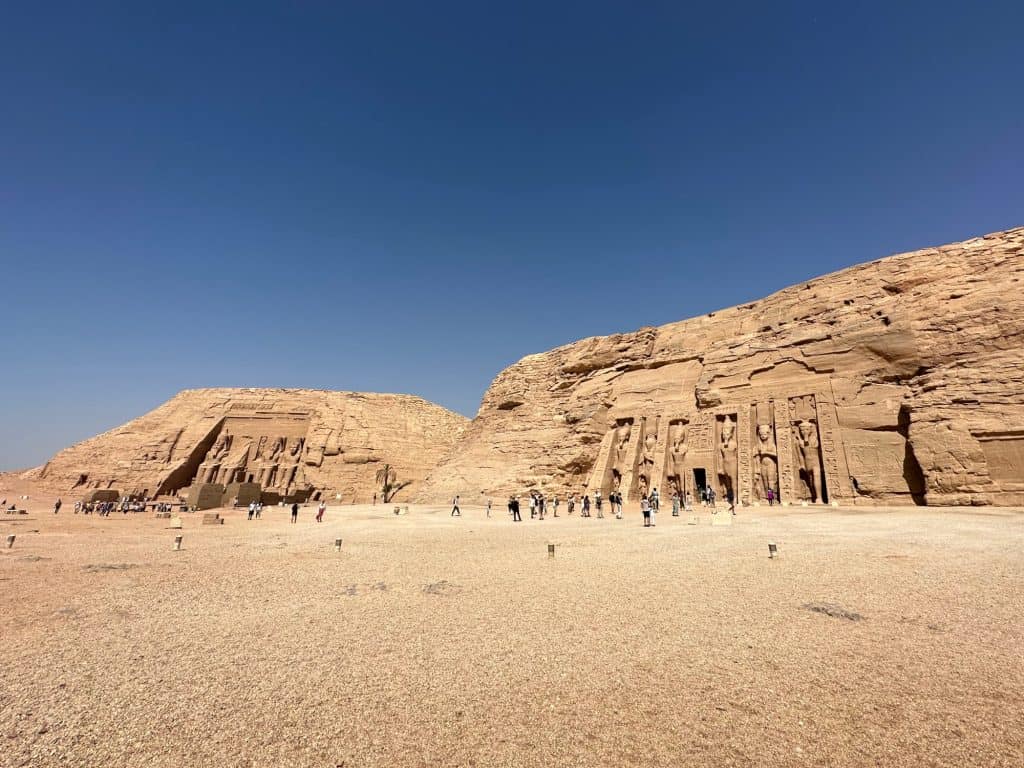
Abu Simbel was built by Rameses II or just ‘Rameses’ as he was the most significant Egyptian ruler to use this name.
He lived into his 90s and reigned for 33 years – no mean feat when most ordinary Egyptians would be happy to make it to 30.
This meant he had a lot of time on his hands to cement his place as Egypt’s supreme ruler and as a god.
It’s thought that the temples of Abu Simbel were built here in the far south not because he visited often but as a show of his power.
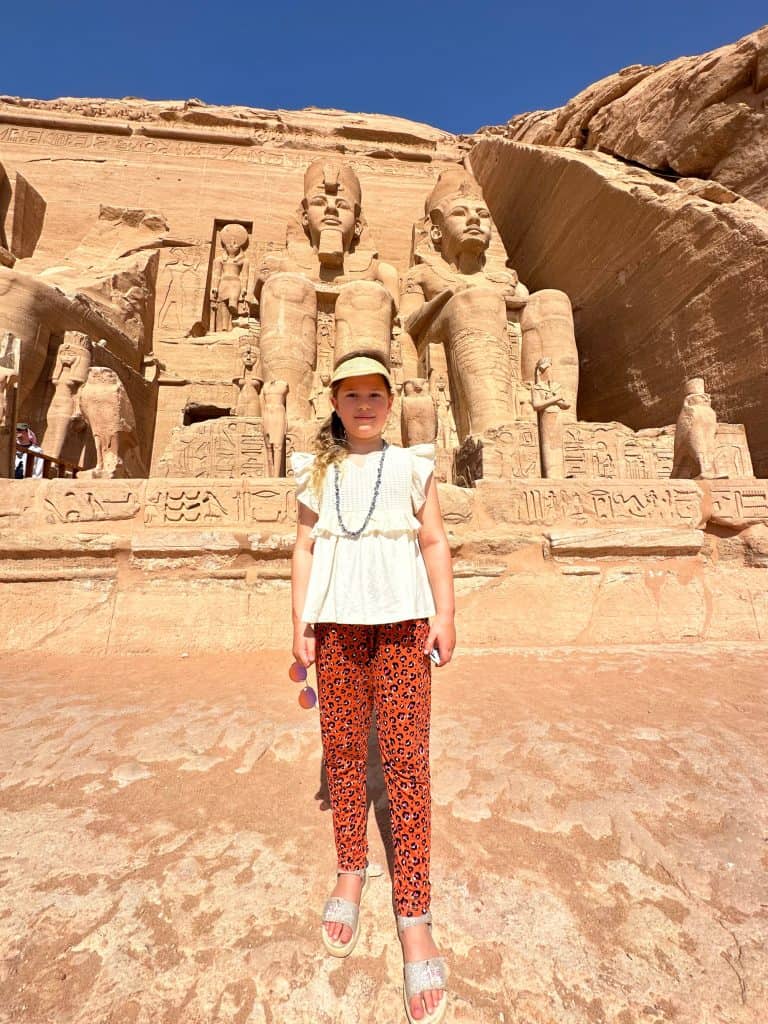
Inside there are huge hieroglyphs depicting Rameses’ triumphs in war and showing him as equally powerful as the gods.
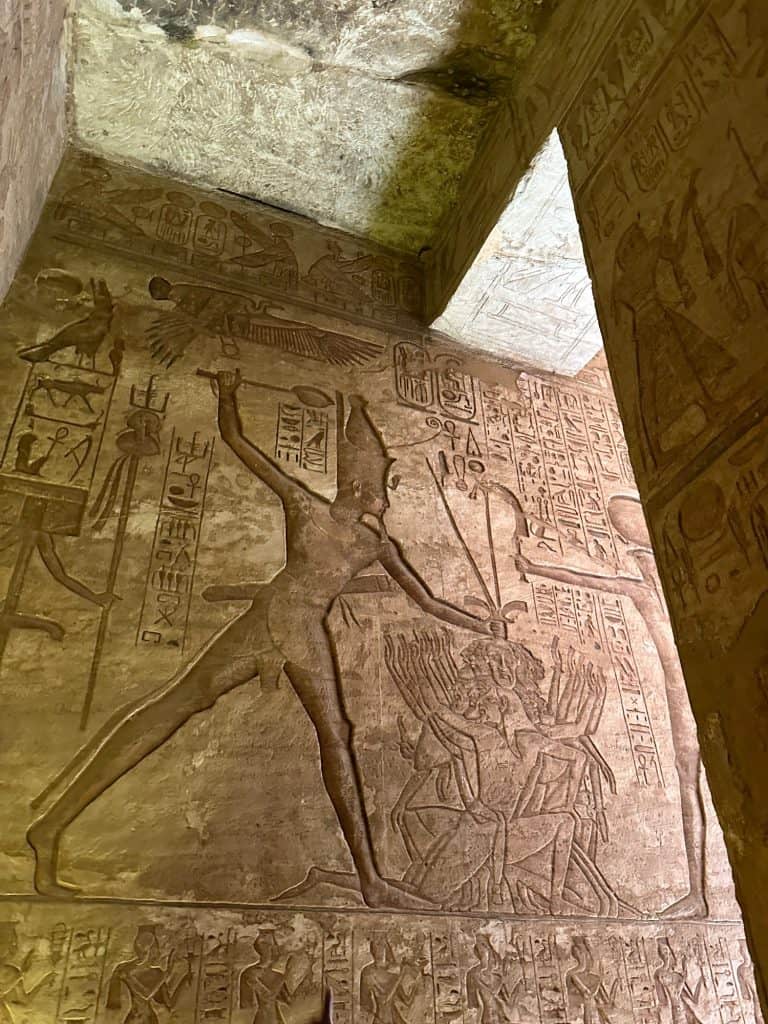
Alongside the grand temple dedicated to Rameses is a smaller one in honour of his favourite wife Nefertari. He had 44 wives and it is her alone who is represented as an equal.
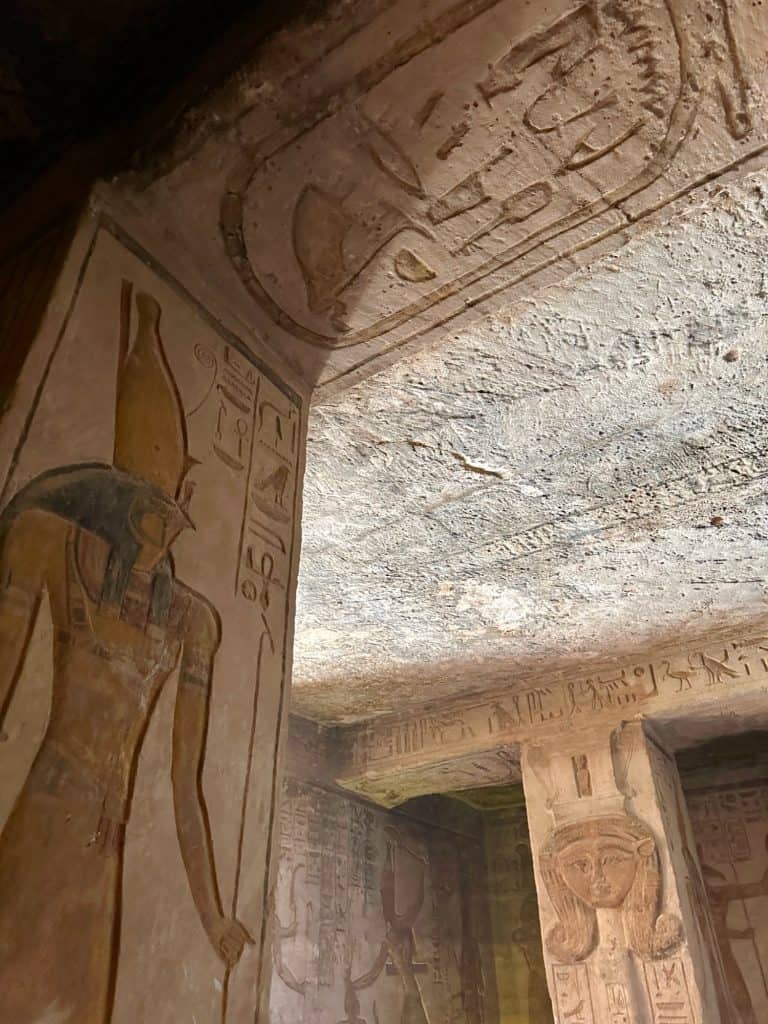
Like many of Egypt’s architectural treasures, these temples were lost for centuries to the desert sands.
They were rediscovered in the 1800s when a boy called Abu Simbel guided an archaeologist to where the baboons at the top of the large temple could be seen peeping out of the sand.
A century later the temples were moved 200 metres from their original location before Lake Nasser flooded the land. This laborious task took eight years.
How to avoid the crowds at Abu Simbel

Our excursion to Abu Simbel was built into our Egypt itinerary, so we took our travel agent and guide’s advice on when to visit.
We knew going right at the beginning of the day would be the most comfortable time in terms of the heat, despite it being a red eye start.
This worked out well for us as we were able to rest in our mini bus on the drive out and back.
However, if you want a better chance of getting Abu Simbel to yourselves (a lot of people do this to get the best pictures), you need a different tactic.
Setting off from Aswan later in the day will help you avoid the crowds. Just be prepared for the extreme heat of the day. As a family this wasn’t a good option for us.
Of course, if you did decide to set off from Aswan later you still need to start heading back just after lunch before the road closes again.
Setting off at 4.30am and spending two hours at the temples allowed us to get back to our hotel by 1.30pm.
Afternoon felucca ride on the Nile

We’d been undecided about the afternoon activity in our Egypt itinerary after such an early start.
However, we decided to push on through for our felucca ride and I’m glad we did.
After getting the kids a quick top up snack from the hotel buffet we found our pre-booked felucca waiting just in front of our hotel.
A felucca is a traditional African/Mediterranean open deck sailing boat with a canvas shade and cushioned seats down the sides.
All we had to do was sit back and enjoy the ride.
Amusingly there was very little breeze, so our Nubian captain put in a call his brother to tow us up river with his motorboat. He had a good sense of humour, playing Adele’s Hello on his bluetooth speaker to wind up our guide Adel.
Once we were sufficiently in the flow of the Nile we slowly tacked back watching animals graze along the river bank, and getting a better look at tombs on the west bank and old Aswan on the hills behind the modern city.

We finished the day with an obligatory dip in the pool at sun set and dinner at a cafe a short walk from our hotel. By now we trusted Adel to pick out somewhere good for us to try local food. We all enjoyed plates full of shawarma, kebab and kofta.
Our hotel in Aswan

While based in Aswan we spent two nights at the Tolip Hotel overlooking the River Nile. I could have spent many an evening drinking in the view from our balcony.
Despite our tight sightseeing schedule the kids were keen to fit in two trips to the riverside pool complex which you access from the main hotel via a tunnel that takes you under the road.
This was the best place to appreciate the comings and goings of felucca and cruise ships.
The Tolip was the grandest hotel we stayed in with a huge atrium, glass lift and lobby fountain. The food and staff were also great. The fresh mango and chocolate milkshakes were worth a little wait.
We were allocated inter-connecting rooms with balconies. The girls’ room had been set up with twin beds and ours was a proper super king.
The decor was a little tired but everything was very clean and we had plenty of room to sit indoors and out.
It may have been a hangover from our sleeper train experience and the overnight noise of Cairo but we all slept incredibly well here.
Compare rates for hotels in Aswan*
Day 5: temples on the road to Luxor
It was a relief to set off for the next stage of our Egypt itinerary at a more civilised 9am.
Today we travelled 150 miles back along the same route as the sleeper train to Luxor with stops to see more of Egypt’s incredible temples.
We drove beside date palms, mango trees and tethered mules. Men wearing linen robes and turbans crouched in the shade, while children jumped into canals running parallel to the river.
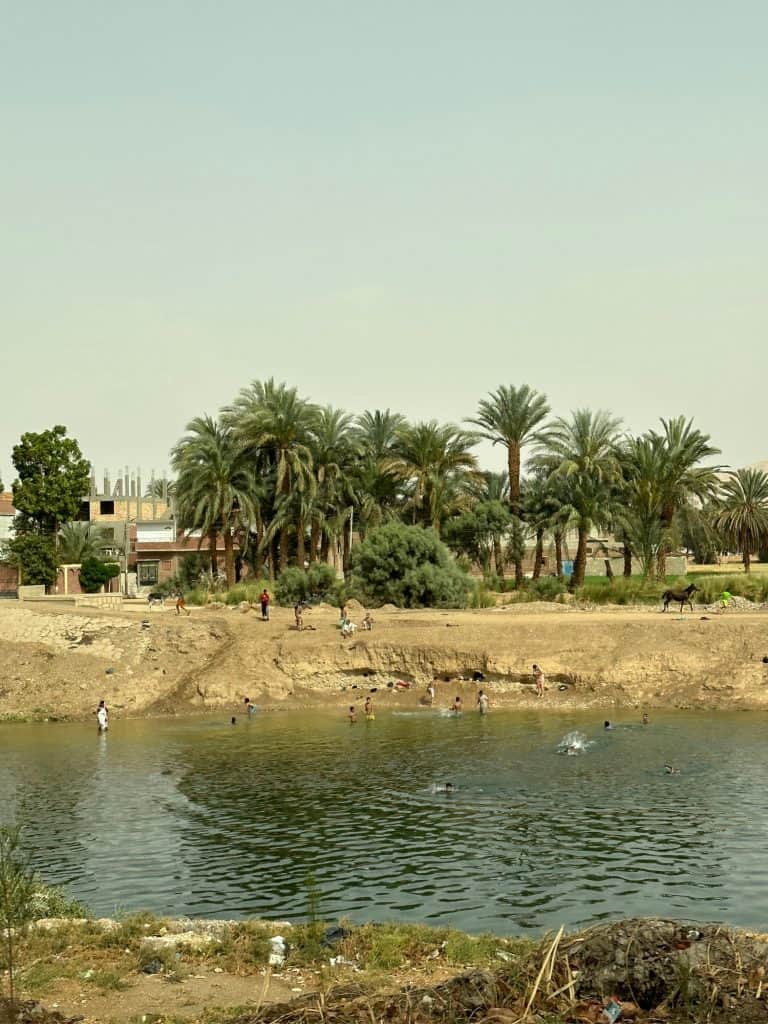
We passed three wheeled vans, tuk tuks, donkey drawn carts, and lorries carrying sugar cane.
These authentic sights of modern Egypt were a welcome distraction from the state of the road. It was a slow and bumpy four hour ride.
Thankfully we had some rather impressive pit stops.
Kom Ombo Temple and Crocodile Museum
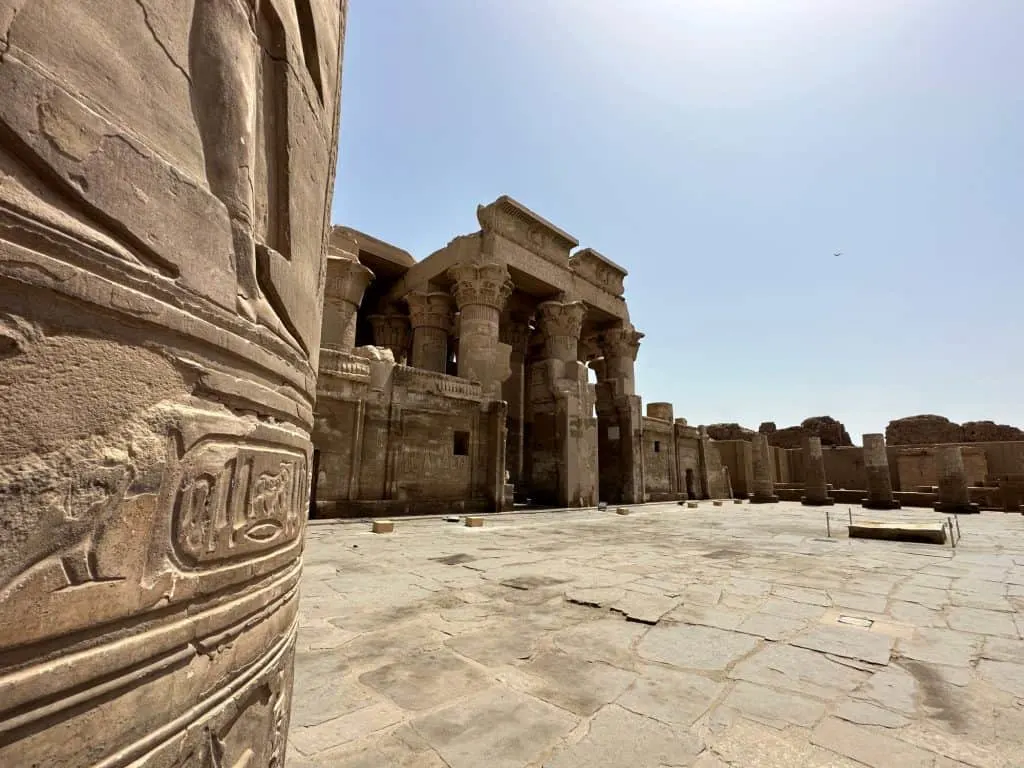
After an hour we arrived at the temple complex of Kom Ombo beside the Nile. This is the only temple in Egypt dedicated to two gods: Sobek and Horus.
The Graeco-Romans built it to appease the two warring gods, giving them equal shares in the temple from the entrance to the sanctuary.

It’s not just its dedication that makes this temple unique.
Kom Ombo Temple the only ancient site in Egypt where you can see a depiction of a mother giving birth and breast feeding.

From the sublime to the absurd, it’s also where 300 mummified crocodiles were discovered.

Of course, there’s a legend about them – as always, Adel was ready to share this with the girls – but you can also see some of them in a museum next to the temple.
The kids had been looking forward to this and marvelled at the shrivelled reptiles in their glass cases. It was another example of how this Egypt itinerary works for children as well as us adults.
After 40 minutes, we were back on the rutted road to Luxor.
Edfu

An hour and a half later our bums thanked us for giving them another break at Edfu – 60 miles south of Luxor.
Most visitors to Egypt’s second largest temple arrive from Nile cruses early in the morning. So it was very quiet when we pulled up at lunch time.
Edfu is not only huge. It’s also the most intact temple in the country. Much of it looks like a film set! Its preservation is again thanks to being buried in sand for hundreds of years.

This is another temple from the Graeco-Roman era and was only rediscovered 200 years ago. The Greeks built it to honour the Egyptian god Horus which they aligned with their own god Apollo.
Throughout the temple there are images of Horus with other gods. Some of the hieroglyphs still sport their original colours while others were defaced in the 4th Century AD when non-Christian worship was outlawed.
The most impressive features of Edfu are the huge columns. But they were nothing compared to the next temple we were to see.
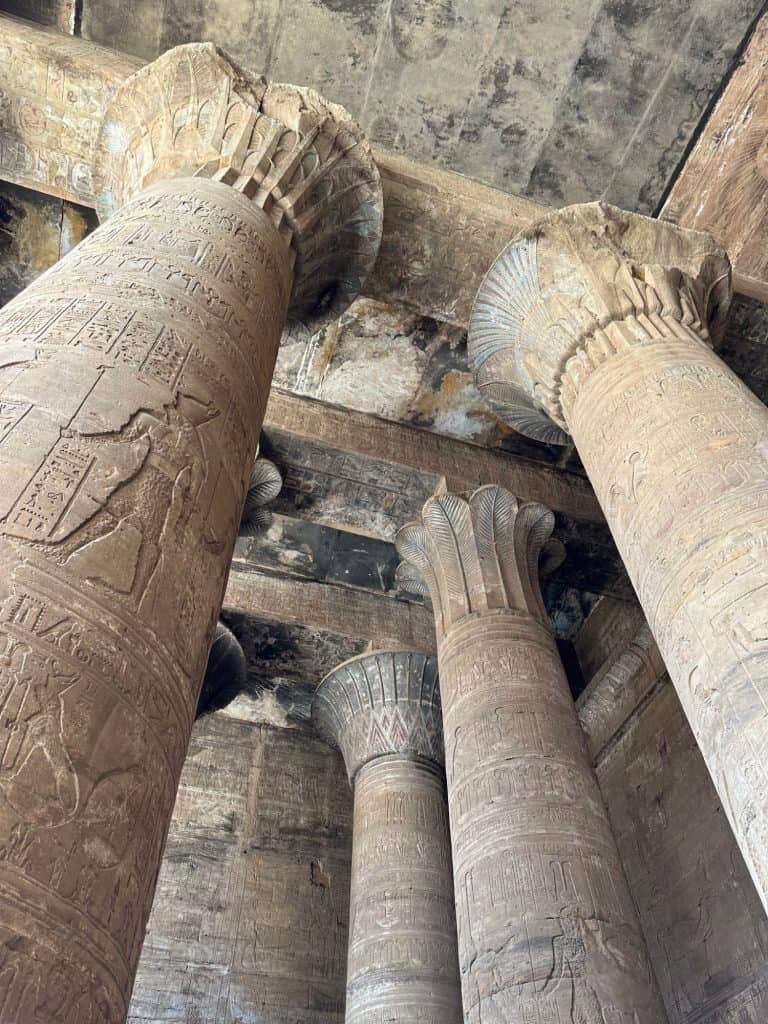
The final stage of our transfer to Luxor continued alongside the railway line. We passed mud brick villages built below hills peppered with tombs long since raided for their treasures.
The more hilly nature of this region is one of the reasons why the pharaohs chose it as their gateway to the next life after the pyramids failed to keep them and their valuables safe.
Luxor
Luxor is home to some of Egypt’s most famous sites after the pyramids. You can visit the Valley of the Kings, Karnak Temples and Queen Hatshepsut’s temple all in a day.
We had two days here and enjoyed our first proper bit of down time alongside seeing the historic sites.
Our accommodation, the Pavilon Winter Luxor Hotel*, was set in shady gardens just across the road from the Nile. We didn’t have river views this time but we could see the resident flamingos roaming around the palm trees in the morning.
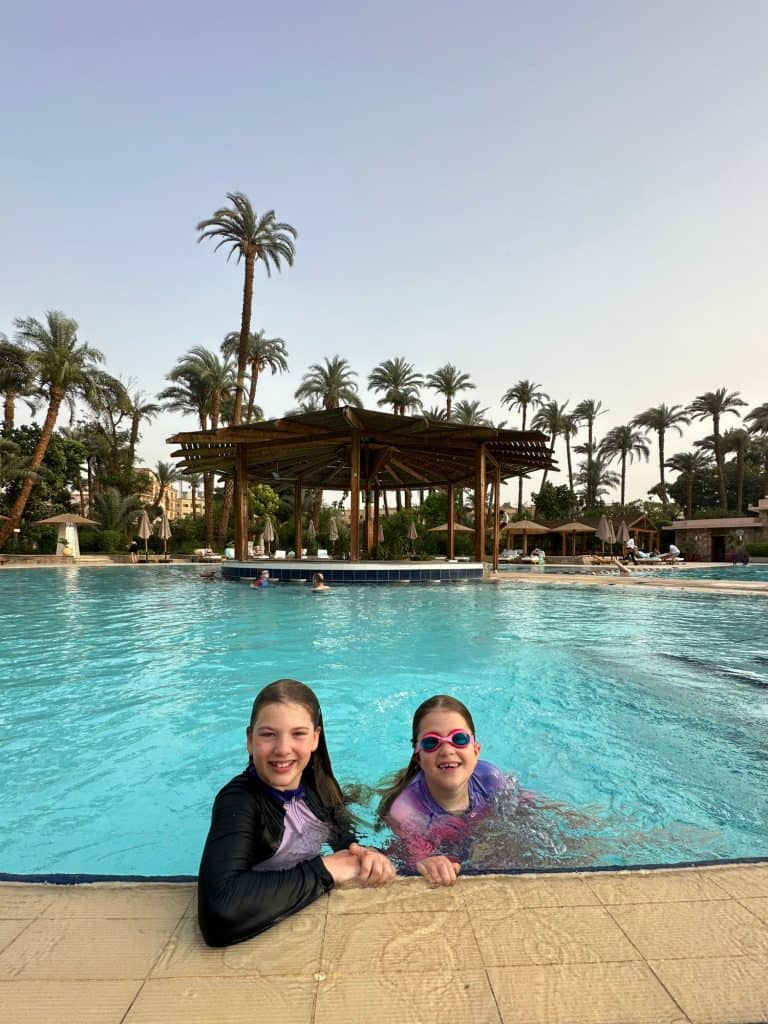
We had time to unpack and lounge by the pool before our evening excursion.
Karnak Temples Light & Sound Show
This was the only activity we added to our 10 day Egypt itinerary for an extra £40 per person. Again, I’d wondered whether we should do it because it was creeping into much needed downtime at the end of the day.
However, it was our one opportunity to see an evening show at a temple. And when in Egypt…
Dining with views of Luxor Temple
Before heading to Karnak Adel took us to Aboudi Coffee Break – a restaurant with a balcony where we ate in view of Luxor Temple.

Adel worked his local contacts book to get us a table at the front from where we got a spectacular view of the temple.
The food was also excellent with plenty of choice including kid-friendly meals like nuggets and burgers. The girls were craving a bit of bog standard grub after five days of trying lots of new foods.
When we finished it was time for the main event. Adel called our mini bus and we drove to Karnak.
Karnak Temples
The temples here were built by successive pharaohs over a period of 1,800 years. Unsurprisingly it’s the largest complex of ancient buildings in Egypt.
Even the columns are huge. You could stand 50 people on the top of some of the largest ones. They make an impressive backdrop for the late night light and sound show.
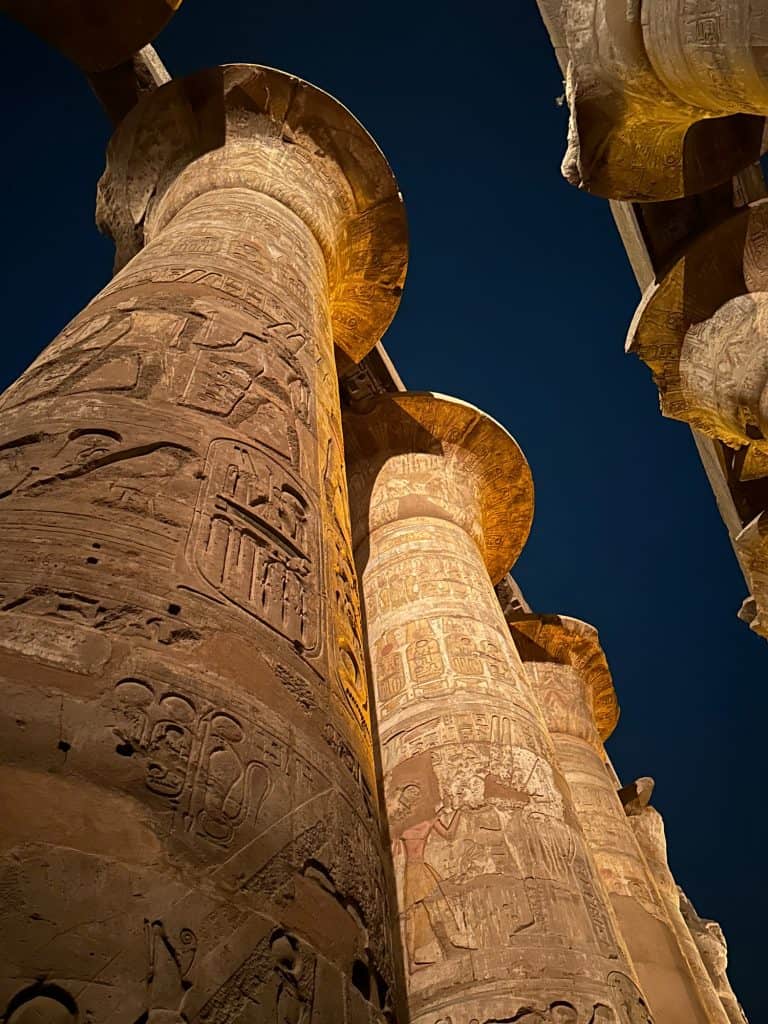
Despite watching The Spy Who Loved Me several times as a kid I wasn’t really sure what to expect.
We arrived just before 9pm – pushing the kids to their limits again – and waited at the entrance to the temples. Quite a crowd gathered before a disembodied voice signalled the start of the show, inviting us to step inside.

The first part of the show is a walk-through experience.
Images are projected onto the temple walls and statues as the voices continue to talk about Egypt’s ancient rulers. It recapped and consolidated a lot of the information we’d learnt so far during our Egypt holiday.

There are several stops at important statues and structures.
After half an hour you take a seat overlooking the sacred lake. The tale continues with lights highlighting important structures within the temples in front of you. This part lasted for another half hour.
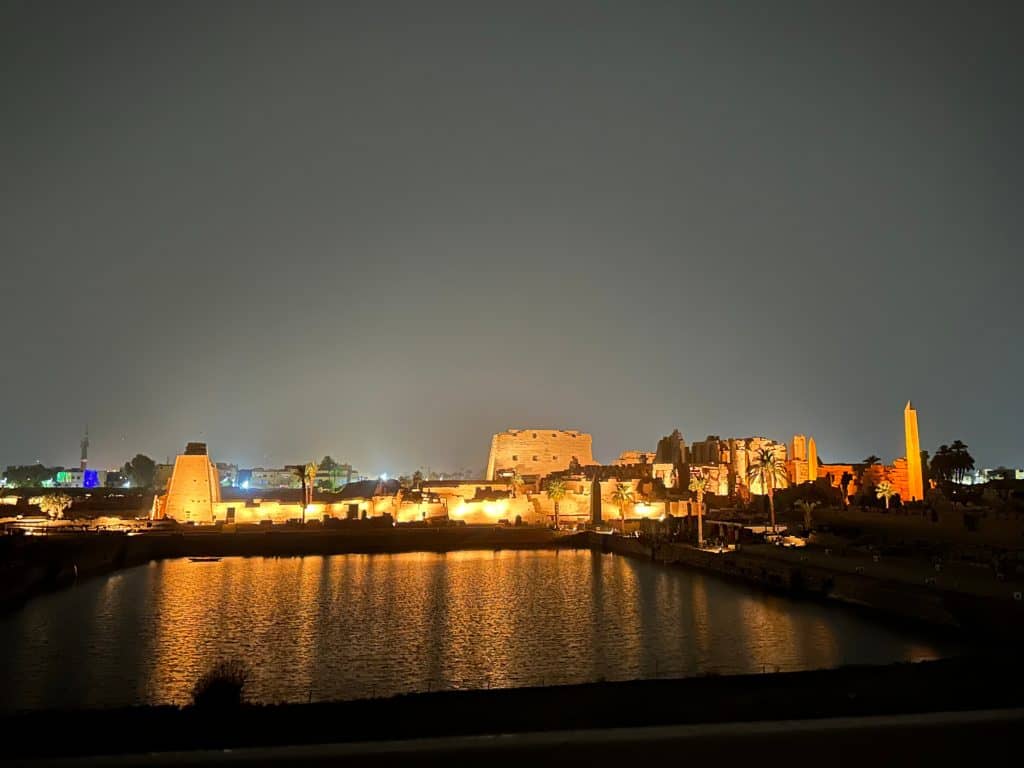
Despite the lateness of the show we’re glad we did it. Karnak wasn’t included in our Egypt itinerary as standard. We could have fitted it in rather than a trip to the pool but I know that wouldn’t have gone down well with the kids.
The temperature was also a lot more comfortable at night and there was a great atmosphere.
Day 7 – Luxor and Valley of the Kings
The good news the next morning was that we were just over half an hour from the day’s sightseeing spots, so our start time was 8am.
This still felt like a lay in after Abu Simbel a few days before. By now you’re probably thinking that an Egypt travel itinerary is non-stop. Yes, but bear with me…days eight to 10 were much more relaxed.
At the Winter Pavilon Luxor you’re actually very close to the Valley of the Kings as the crow flies. But we needed to cross the Nile and Luxor Bridge is a 20 minute drive in the wrong direction.
Colossi of Memnon and temple of Amenhoteb III

Once on the East bank we made a quick stop at the Colossi of Memnon – the second largest statues in Egypt.
The pair are pretty much all that’s left of the temple of Amenhoteb III which was destroyed by two earthquakes. It is still being excavated.
Adel called this a ‘Kodak’ moment. It was somewhere to pause to let earlier visitors filter through the day’s main attractions ahead of us.
It really says something about how amazing Egypt’s history is when 18 meter high statues are a side show.
Temple of Hatshepsut – Deir Al-Bahari

We arrived at Deir Al-Bahari just after 9am and it was already heaving with people.
Golf buggies take visitors up a long drive to the first set of steps (for an extra charge). Adel picked up our buggy tickets at the same time as our entrance tickets. Even though it was early we were grateful not to have to walk in the heat.
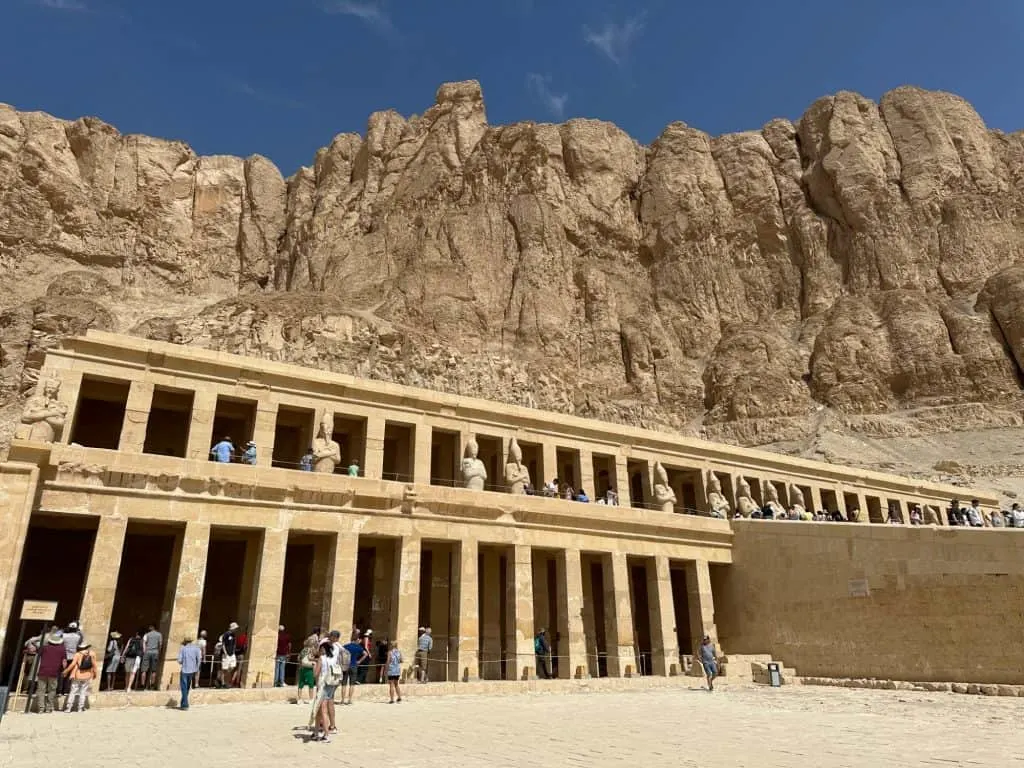
Hatshepsut was a fascinating figure in Egypt’s history. She ruled Egypt alongside her brother, Tutmose III, and built this temple for Amun. Despite being a peaceful pharaoh under whom Egypt prospered she wanted to rule by herself and sidelined Tutmose.

When she died he reclaimed his thrown and erased her, which accounts for the damage to the temple’s hieroglyphs and statues.

There are still some incredibly well preserved colours and artwork in the less exposed areas.

The temple looks long and thin from a distance but in fact it is made up of three rectangular levels with their own rooms containing colourful murals.
It’s in an incredible location, backing onto the Valley of the Kings and overlooking Luxor and the Nile.

This was my favourite temple in Egypt because of its unique design. We spent an hour wandering around the different levels and admiring Hatshepsut’s statues before our final stop of the morning.
Valley of the Kings

The Valley is just on the opposite side of the cliff to Deir Al-Bahari.
On the drive around you pass Howard Carter’s house. He lived and worked in it for 15 years while excavating in the Valley.
It’s now a museum where you can see Carter’s reproduction of Tutankhamun’s tomb.
The Valley of the Kings has a visitor centre at its entrance. There’s a scale model of the valley showing you where you’ll find each of the 63 tombs that have been discovered.
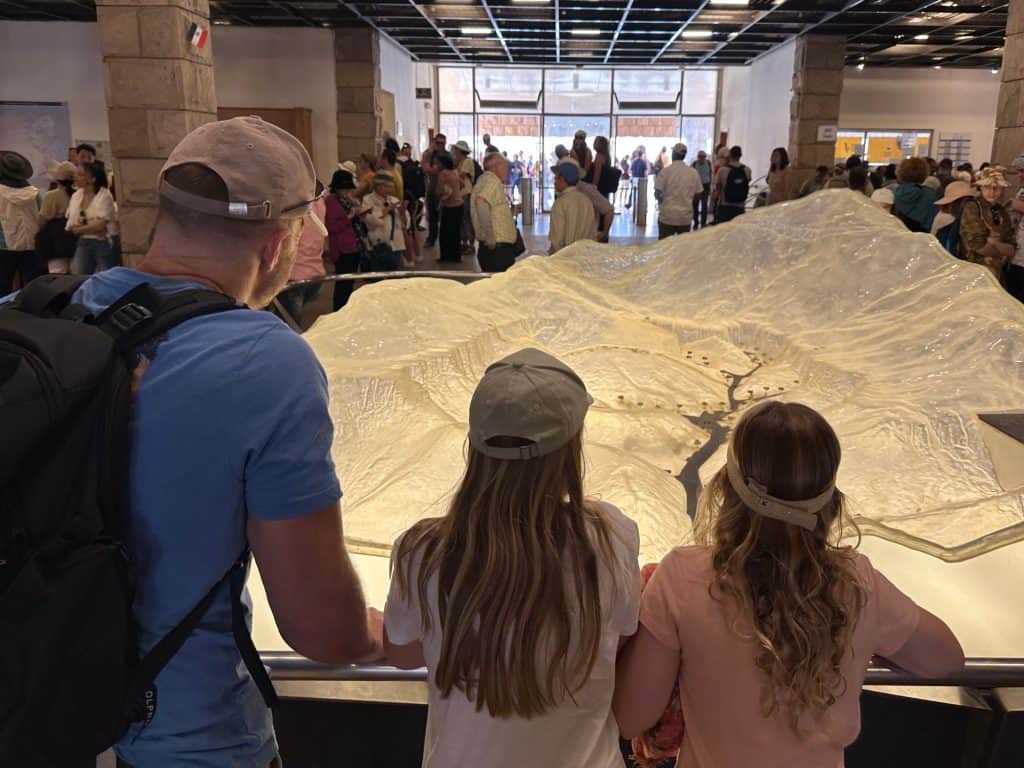
This is a good place to pause and appreciate how difficult it must have been for some of the later pharaohs to find an unused plot. As we were to find out, some had to make detours when they accidentally unearthed another king’s burial site.
On the other side of the visitor centre you can take another buggy ride (you need to buy an extra ticket again) along a road to the Valley.
If you’ve seen the Valley of the Kings in documentaries you’ll find it looks very familiar. A central path has offshoots to gated tomb entrances where guards sit ready to punch holes in your tickets.
Standard entry into to Valley includes access to three tombs of your choice. If you want to visit Tutankhamun’s tomb you must buy a separate ticket.
On Adel’s advice we didn’t. There are much more impressive tombs in the valley.
These are the ones we visited:
KV2 – the tomb of Rameses IV
We were blown away by this first tomb. It as wonderfully preserved colours in the intricate hieroglyphs.

There’s a gradual slope down to the sarcophagus so it’s easy to do with children.

KV8 – the tomb of Merenptah
This one is deep and steep, so not great if you’re visiting with young children.

But this tomb demonstrates the incredible architectural skills and craftsmanship of the ancient Egyptians.
It wasn’t finished when Merenptah died so the domed mortuary at the bottom is not decorated.

KV11 – the tomb of Rameses III
This one is fascinating for kids who like gruesome details. This Rameses was buried with a screaming mummy.
There are stories of an attempted coup in his family and several relations are thought to have been executed and buried with him.

The tunnel down to the burial chamber also has a kink in it half way. This is because the workers bumped into another tomb when they were digging.
You need at least an hour and a half to explore the Valley of the Kings. Take plenty of water. Even though you are out of the sun when you are exploring the tombs they are very hot and stuffy. There’s also very little shade on the surface of the valley.
Lunch on the East Bank of the Nile
On our way back to our hotel we stopped for lunch at a local family’s four-storey home. Three generations lived here.
As it was Ramadan they didn’t join us in their entertaining room but they delivered plate after plate of delicious home cooked food – more than we could eat.

The orzo soup was the best we tasted during our 10 days in Egypt. We also tried a traditional bread that is made without yeast and baked in the sun. This was followed by meat balls, chicken, rice, vegetable tagine and a freshly picked banana for dessert.
Rather than drive back to our hotel from here Adel suggested we take a ferry boat across the Nile.
We walked down the side streets, past houses decorated to show the occupants had completed the pilgrimage to Mecca, until we reached the pontoon.

This is obviously a popular way to complete a morning touring the Valley of the Kings as there were lots of other tourists boarding motorboats. Adel secured one just for us and we set off across the river.
Luxor is a very busy section of the waterway as it is where Nile river cruises start.

As we weaved between felucca and other small boats we also had to dodge the apartment block-esque cruise ships.

The scale of a Nile river cruise ship is nothing like ocean going cruise liners, but if you’re on a small boat their wake will make you bob around like a cork. The kids thought this was hilarious.
After one ship had passed our boat driver invited Mr Tin Box to take the helm.
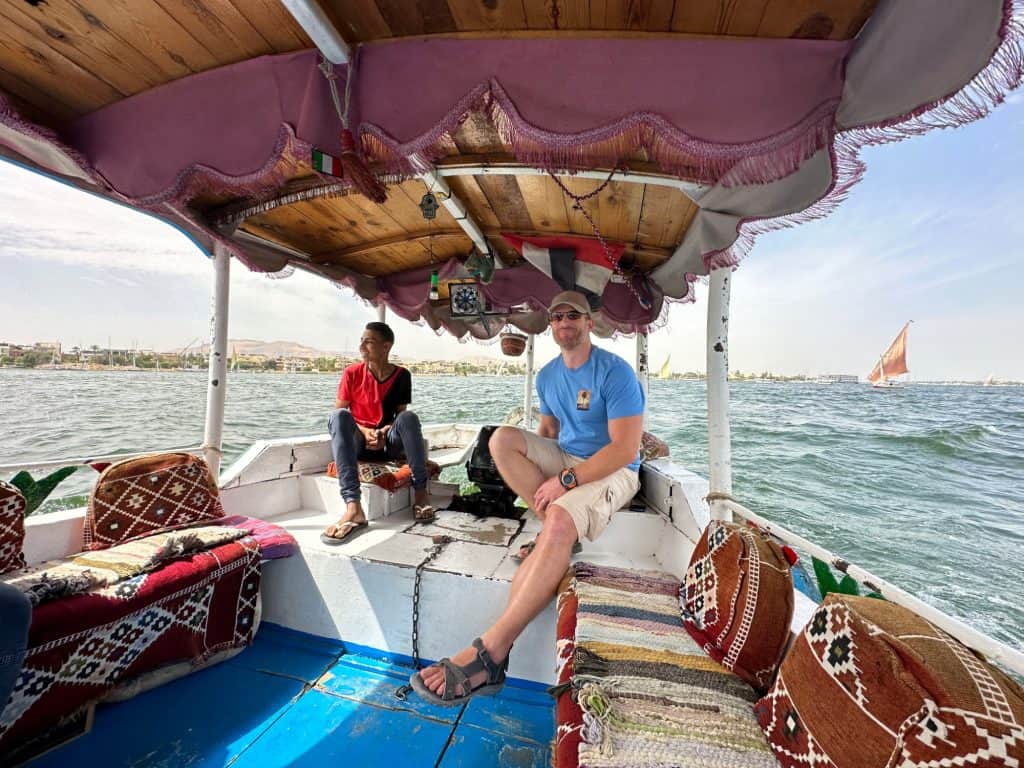
Afternoon and evening in Luxor
The ancient sightseeing element of our Egypt itinerary had now come to an end. I was a little sad but we all benefitted from a relaxing afternoon beside the pool. And we still had another three days in Egypt!
In the evening we took a recommendation from Adel and had dinner at El Sahaby Lane, which was a short walk from our hotel. We arrived at 7pm and this was obviously a busy time as the service was slow. However, when the food did arrive it was very good.
Side note: this was the first main meal we’d bought ourselves, apart from snacks, since Cairo. We were really impressed with what was included in our 10 day tour package.
Luxor souq
El Sahaby Lane is beside Luxor’s main souq so we also went there to find some souvenirs.
Our eyes had been caught by the loose harem pants we’d seen on lots of markets at the historic sights, so we decided to get a few pairs.
We paid about £9 a pair for the trousers, which was reasonable.
Then we got persuaded to buy a handcrafted scarab the size of a large plum. This cost us £18, which I’m sure was a fair price but we hadn’t been looking for it. What we had wanted was fridge magnet to add to our collection, but we gave in to the hard sell.
The souq isn’t somewhere I recommend browsing with kids. There was a lot of hassling, which made it a less pleasant experience than we’d hoped for.
The traders are very keen for you to visit their friends’ shops and once inside it is harder to stop them pressing small gifts into children’s hands.
If you do go, have a mission and stick to it otherwise you could come away with all kinds of things you don’t want or need. We made a quick exit after buying our off mission scarab, which is a shame as I’d liked to have looked around some more.
Unsurprisingly I took zero pictures because we were so distracted.
As I mentioned earlier, a lot of people have asked me if we felt safe in Egypt and we absolutely did. But did we feel harassed?
This was the only time we felt really hassled in Egypt. It was our one evening out without Adel so I suspect that might have shielded us from over-zealous sales pitches elsewhere.
Our hotel in Luxor
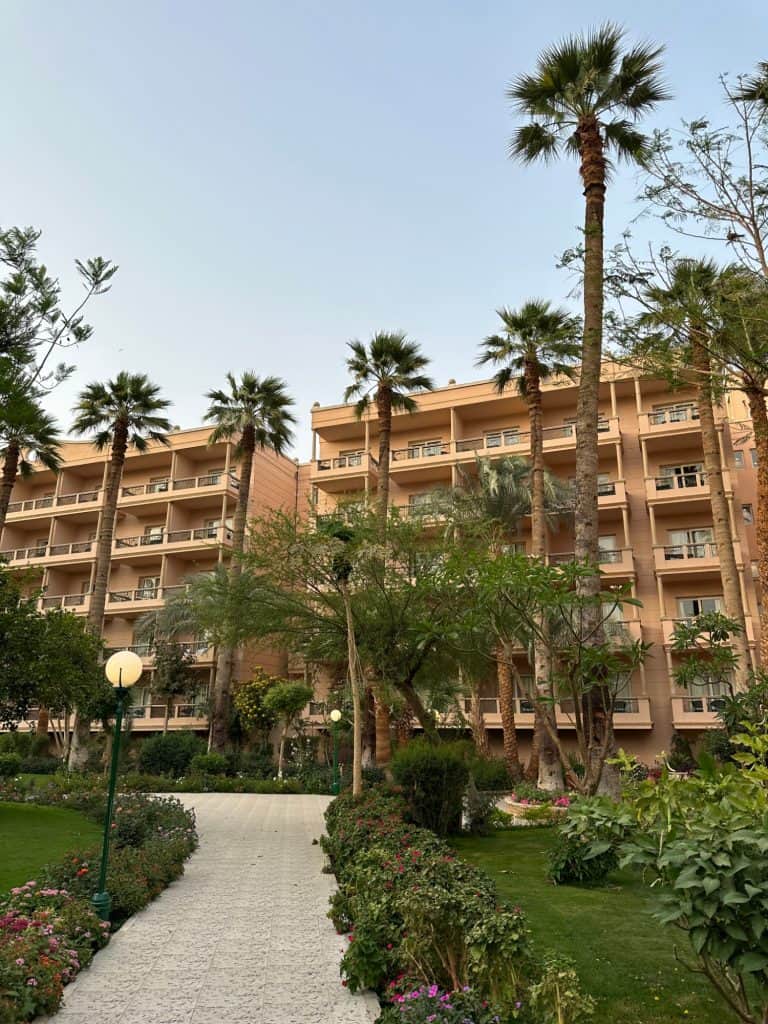
We stayed in the Pavilon Winter Luxor Hotel*, not to be confused with the Sofitel Winter Palace* just in front of it.
We thought the Pavilon Winter Luxor was a fantastic hotel but some of the service let it down.
It’s set in tropical gardens with a looped pool for lounging and a rectangular one for serious swimming. Along side this there was a bar and kitchen that we used to buy drinks and snacks during our afternoons.

The rooms were well decorated and very comfortable. We had interconnecting rooms with twin beds and balconies overlooking the gardens. The girls enjoyed waking up and seeing the resident flamingos roaming the grounds below.

A peculiarity for a five star hotel was that there was no kettle in our rooms. The shower head had also been fitted at the wrong end of the bath so there was no shower screen.
The staff cleaning our rooms and serving beside the pool were friendly and efficient. However, the restaurant staff were disorganised.
At breakfast the tables weren’t cleared, hot drinks had to be chased and the buffet looked like it had been visited by locusts by 7.15am.
Compare prices of hotels in Luxor*
Days 8 to 9 – Hurghada
On our eighth morning we were picked up at 8am for the final road trip of our 10 day Egypt itinerary. We drove through Luxor and the villages to its west before joining the highway towards the Red Sea.
It was a long four hour drive but we were all excited about the change of pace and a chance to absorb everything we’d seen over the past week.
We checked into our all-inclusive hotel, the Mercure Hurghada, grabbed lunch from the buffet and had a little explore before our rooms became available.
And then we hit the relax button.
Our hotel in Hurghada

The Mercure Hurghada* is a sea front resort aimed at the European market with three free-form swimming pools, sun beds on the easterly facing beach and water sports centre. There’s also a kids club, shops, and daytime and evening entertainment.
The rooms have an unmistakeable Accor style with purple seating and plum cushions.
We had connecting rooms on the ground floor with small private terraces overlooking one of the grassed areas. We were a few minutes walk from all the facilities.
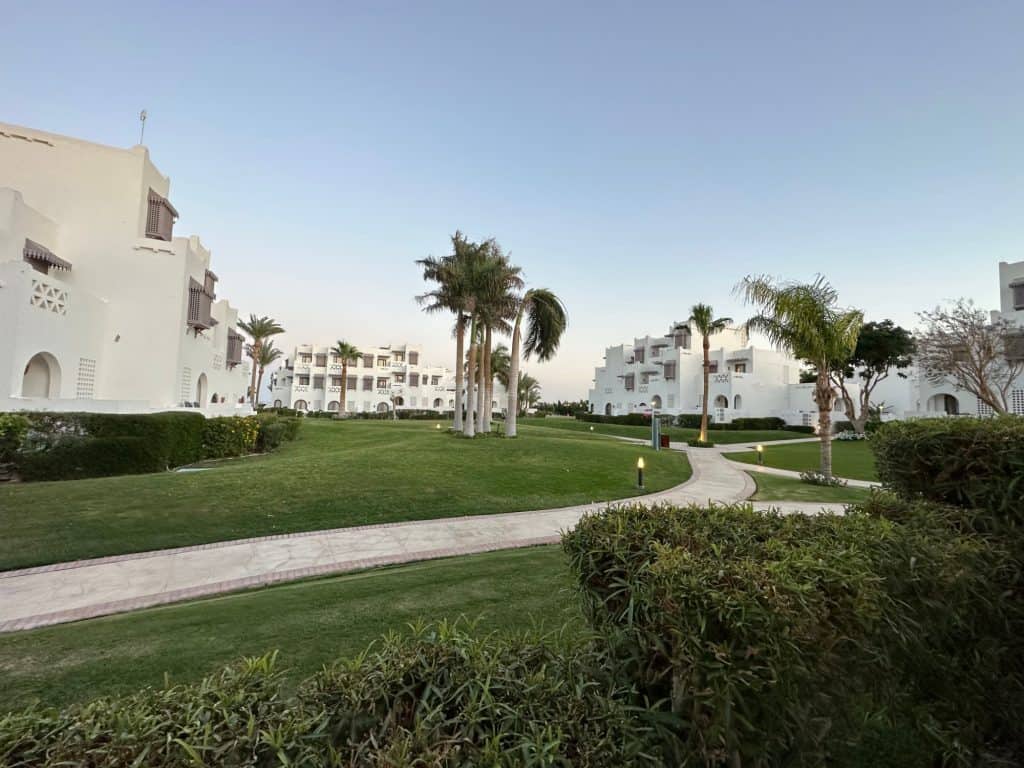
The all-inclusive food and drink included the buffet, ice cream by the pool, local lager and spirits in the bar and wine with meals.
You could also buy hot snacks by the main pool and every guest can visit two of the al a carte restaurants during their stay. However, these have to be booked well in advance. All the tables had already been reserved during our two night stay.
This was a bit of a disappointment as we had hoped to try the Asian restaurant. However we enjoyed the food in the buffet. There was a good variety of international dishes and everything was well stocked. It never felt over busy.
The Mercure* is a good family hotel in Hurghada.
The only thing missing that we had spotted at other resorts close by was a water park with slides. Our girls soon forgot about those and made the most of unlimited pool time.
Check out other hotels in Hurghada*
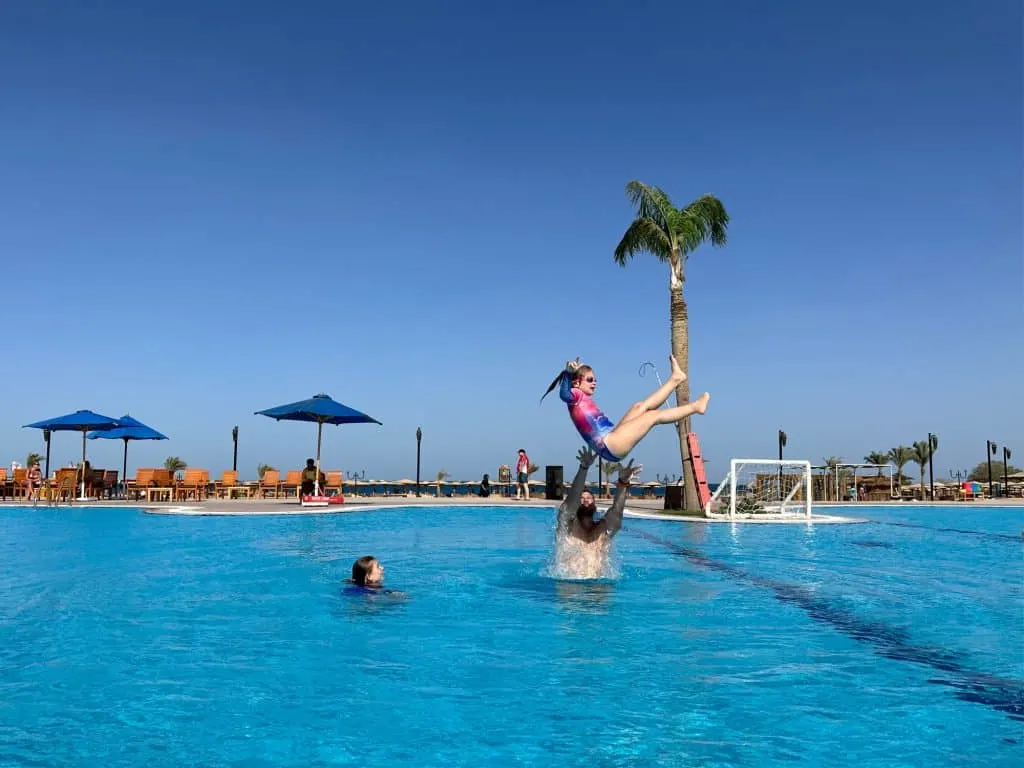
Activities on the Red Sea
Sadly our snorkelling excursion planned for day nine was cancelled due to windy weather, so we decided to do some activities at the resort.
Mr Tin Box had been promising the girls and I a trip to a spa if we found one and the Mercure Hurghada was the first of our Egypt hotels to deliver.
We booked a manicure and pedicure, and Mr Tin Box was persuaded to have a facial. I got upsold a facial, wax and tinted eye brows and spent a luxurious three hours being pampered. Oops!
The rest of the afternoon was spent hopping between the pool and kids club where the girls did crafts and played games.
At 5pm we took a sunset horse ride along the beach. The El Rancho stables are right next to the hotel and Mr Tin Box went over to check them out before we booked to make sure that the horses looked happy and healthy.

The staff at El Rancho were great. They sized us all up for riding helmets and half chaps, and recognised when some riders were feeling nervous.
Our girls were both so excited about the ride but also a little edgy as they are very much novices. We all were!
The horses know where they are going so you don’t need to be a competent rider. But they did at times get distracted by each other and tasty looking hedges.
This made our 10-year-old a little uneasy, so one of the stable team stayed with her for the whole ride.
We did a loop around the resort along the beach and back to the stables with a few photo opportunities along the way. Our ride lasted an hour and was a lovely way to finish our last full day in Egypt.
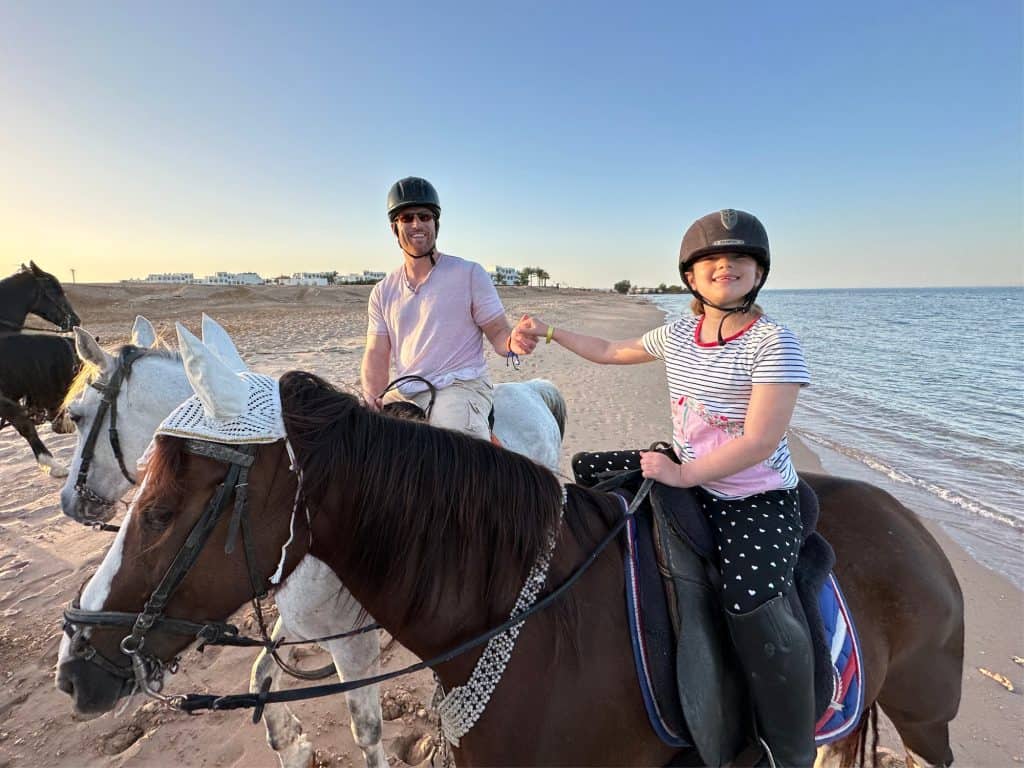
In the evening we went to the mini disco in the resort’s covered amphitheatre. The kids loved this and despite being shattered asked to stay on and see the evening show which was a father/daughter acrobatic and juggling act.

Day 10 – Departing for Cairo
The last day of any holiday can be a bit of a downer but we started this one knowing we didn’t have to leave the hotel until 3pm.
A week before we flew to Egypt our airline cancelled and rescheduled our return flights. It was a bit of a faff as we would be taking a red eye flight home but we looked on the bright side that we’d have some extra time in Egypt.
As soon as we found out I contacted Families Worldwide and they arranged for us to have a later check out on our last day. This was perfect as we got a morning beside the pool rather than sat in departures at Cairo International Airport.
We still got up early to say goodbye to Adel who had remained at the hotel and in contact should we have needed anything. He was flying back to Cairo for a couple of nights before meeting his next tour.
We had an excellent time with Adel and would definitely seek him out again if we re-visit Egypt.
After breakfast, the girls were keen to go back to the kids club while we sat by the pool.
The weather had turned cooler so we luxuriated in this knowing we were going back to temperatures 10 degrees higher in Oman.
At least we didn’t have the weather to blame for our post-Egypt blues!
Summing up our 10 day Egypt itinerary

What an incredible experience. If you are a lover of history Egypt has to be on your wish list. The dates covered by the ancient sites blew my mind.
As I mentioned earlier, we haven’t done a fully guided holiday before, usually favouring a slower pace and immersing ourselves in scenery.
But Egypt is not a place where you revel in the landscapes, although the River Nile is undeniably romantic. You’ll not forget seeing the sun set while feluccas slip through the reed edged blue water.
Egypt is more about people – past and present – and their incredible stories.
It feels very special to set foot in places that were lost for centuries and still have so much to reveal.

In order to absorb all of this history and make the most of our 10 days we had to have a strict Egypt travel itinerary. And that’s why a structured tour made sense.
Would we do one again? Yes, if the destination was as steeped in history as Egypt.
Would we visit Egypt again? Absolutely. Even though we ticked off some of the biggest attractions, there’s still so much to see and do.
I’d go back to experience the night life in Aswan, visit Luxor Temple and Karnak by day, to see the new museum in Giza, experience a Nile cruise and do that snorkelling trip we missed in the Red Sea.
I suspect it wouldn’t take much to fill a whole new 10 day itinerary!
See more from our trip in my Egypt Instagram Stories – there are two – or by searching #TinBoxEgypt.
Disclosure: this post contains affiliate links. If you click on one of these links and make a purchase I may earn some commission. This does not affect the price you pay.

